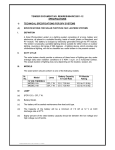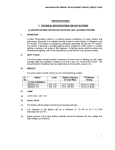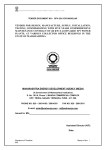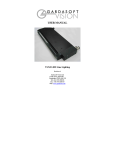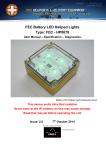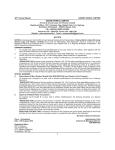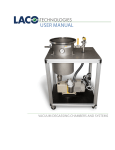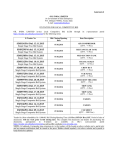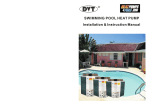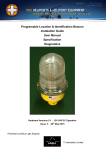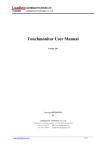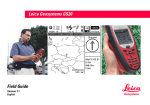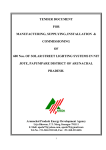Download Technical Specifications of Rate Contract for various
Transcript
MAHARASHTRA ENERGY DEVELOPMENT AGENCY (MEDA), PUNE TENDER FOR RATE CONTRACT FOR THE YEAR 2014-15 FOR DESIGN, MANUFACTURE, SUPPLY, INSTALLATION, TESTING AND COMMISSIONING, WITH COMPREHENSIVE MAINTENANCE CONTRACT FOR 5 YEARS, OF VARIOUS RENEWABLE ENERGY SYSTEMS IN THE STATE OF MAHARASHTRA TENDER DOCUMENT NO. REN/RES/007/RC/2014-15 TECHNICAL SPECIFICATIONS FOR RENEWABLE ENERGY SYSTEMS 1) SPECIFICATIONS FOR SOLAR LANTERN SYSTEM DEFINITION A Solar Lantern is a portable lighting device consisting of a PV module, battery, lamp, and electronics. Battery, lamp, and electronics are placed in a suitable housing, made of metal or plastic or fiber glass. The Solar lantern is suitable for either indoor or outdoor lighting, covering a full range of 360 degrees. PV module converts sun light into electricity, charges the battery which powers the luminaire. Luminaire consists of Compact Fluorescent Lamp (CFL) and an Electronic Circuit. BROAD PERFORMANCE SPECIFICATIONS The broad performance specifications of a CFL light source based solar lantern system are given below: PV Module Battery 10 Wp under STC Sealed Maintenance Free (SMF) lead acid battery or NiMH battery or Lithium Ion Battery Light Source 7 Watt CFL luminaire with 4 pins only along with proper pre-heating circuit Electronics Efficiency approximately 85% Duty cycle 4 hours a day under average daily insolation of 5.5 kWh/ sq.m. on a horizontal surface. Autonomy Minimum of 3 days or 12 operating hours per permissible discharge TECHNICAL DETAILS PV MODULE i. Indigenously manufactured PV modules should be used in the solar lantern. ii. The PV module should have crystalline silicon solar cells, and should have humidity, freeze and damp heat test certificate conforming to IEC 61215 Edition II / BIS 14286 from an NABL or IECQ accredited Laboratory. iii. The PV module must have a minimum of 10 Wp at a load voltage* of 16.40 ±0.2 V under the standard test conditions (STC) of measurement. iv. The open circuit voltage* of the PV modules under STC should be at least 21.0 Volts. v. The module efficiency should not be less than 10%. vi. The terminal box on the module should have a provision of opening it for replacing the cable, if required. There should preferably be an arrangement (stand) for mounting the module at an optimum angle in the direction facing the sun. vii. Page 1 of 53 MAHARASHTRA ENERGY DEVELOPMENT AGENCY (MEDA), PUNE TENDER FOR RATE CONTRACT FOR THE YEAR 2014-15 FOR DESIGN, MANUFACTURE, SUPPLY, INSTALLATION, TESTING AND COMMISSIONING, WITH COMPREHENSIVE MAINTENANCE CONTRACT FOR 5 YEARS, OF VARIOUS RENEWABLE ENERGY SYSTEMS IN THE STATE OF MAHARASHTRA viii. A foil/ strip containing the following details should be fixed inside the module so as to be clearly visible from the front side:a. Name of the Manufacturer and/ or distinctive Logo b. Model and/ or Type No. c. Serial No. d. Year of manufacture ix. A distinctive serial number starting with NSM will be engraved on the frame of the module or screen printed on the tedlar sheet of the module. *The load and open circuit voltage conditions of the PV module are not applicable for the system having MPPT. BATTERY i. Sealed maintenance free lead acid battery with a capacity of up to 7 AH, at voltages of up to 12V @ C/20 rate of discharge rate at 27oC. or NiMH or Lithium Ion battery of requisite capacity ii. For lead acid battery, 80% of the rated battery capacity (~ 5.6 AH at 27oC) should be between the low voltage cut off and full charge condition of the battery. iii. Battery should conform to the latest BIS/ International standards. LIGHT SOURCE i. The lamp should be a 7 Watt compact fluorescent lamp (CFL) with 4 pins only along with proper pre-heating circuit. ii. The lamp should preferably be mounted in a base up configuration. For the lantern to be used in the cold areas like Arunachal Pradesh, Himachal Pradesh, Jammu & Kashmir, Uttarakhand, etc. it could have the lamp base down configuration. iii. The housing should be suitable for indoor as well as outdoor use. ELECTRONICS i. The inverter should be of quasi-sine wave/sine wave type with a crest factor less than 1.7 and the frequency in the range of 20-35 kHz. ii. Efficiency of the electronic system should be at least 85%. iii. Electronics should have temperature compensation for proper charging of the battery throughout the year. iv. The idle current should not be more than 1 mA. v. The voltage drop from module terminals to the battery terminals should not exceed 0.6 volts including the drop across the diode and the cable when measured at maximum charging current. Page 2 of 53 MAHARASHTRA ENERGY DEVELOPMENT AGENCY (MEDA), PUNE TENDER FOR RATE CONTRACT FOR THE YEAR 2014-15 FOR DESIGN, MANUFACTURE, SUPPLY, INSTALLATION, TESTING AND COMMISSIONING, WITH COMPREHENSIVE MAINTENANCE CONTRACT FOR 5 YEARS, OF VARIOUS RENEWABLE ENERGY SYSTEMS IN THE STATE OF MAHARASHTRA vi. The PCB containing the electronics should be capable of solder free installation and placement. vii. The electronics circuit should ensure full charging of the battery under different ambient temperatures (0 - 45oC). Further, the electronic circuit should have adequate temperature compensation arrangement for the battery charge regulation set point/ high voltage disconnect for proper charging of the battery throughout the year. viii. Necessary lengths of wires/ cables, switches suitable for DC use and other protections should be provided. ELECTRONIC PROTECTIONS i. Adequate protection is to be incorporated for “No Load” condition, e.g. when the lamp is removed and the lantern is switched ON. ii. The system should have protection against battery overcharge and deep discharge conditions. iii. The load reconnect should be provided at around 80% of the battery capacity status. iv. Adequate protection should be provided against battery reverse polarity. v. A fuse should be provided to protect against short circuit conditions. vi. Protection for reverse flow of current through the PV module should be provided. vii. During the charging, lamp cannot be switched “ON”. INDICATORS The system should have two indicators, green and red. The green indicator should indicate the charging under progress and should glow only when the charging is taking place. It should stop glowing when the battery is fully charged. Red indicator should indicate the battery “Load Cut Off” condition. QUALITY AND WARRANTY i. The complete Solar Lantern with CFL should be warranted for five years and the battery must be warranted for a minimum period of Two (2) years. ii. The Warranty / Guarantee Card to be supplied with the Solar Lantern must contain the details of the system supplied. OPERATION and MAINTENANCE MANUAL An Operation, Instruction and Maintenance Manual, in English and the local language, should be provided with the Solar Lantern. The following minimum details must be provided in the Manual: Page 3 of 53 MAHARASHTRA ENERGY DEVELOPMENT AGENCY (MEDA), PUNE TENDER FOR RATE CONTRACT FOR THE YEAR 2014-15 FOR DESIGN, MANUFACTURE, SUPPLY, INSTALLATION, TESTING AND COMMISSIONING, WITH COMPREHENSIVE MAINTENANCE CONTRACT FOR 5 YEARS, OF VARIOUS RENEWABLE ENERGY SYSTEMS IN THE STATE OF MAHARASHTRA • Basic principles of Photovoltaic. • A small write-up (with a block diagram) on Solar Lanterns - its components, PV module, battery, electronics and luminaries and expected performance. • Significance of indicators. • Type, Model number, Voltage, capacity of the battery, used in the system. • The make and wattage of the CFL used in the lighting system. • Clear instructions on mounting, operation, regular maintenance and trouble shooting of the Solar Lantern. • Instructions on replacement of battery. • DO's and DONT's. • Name and address of the contact person for repair and maintenance during the warranty. Page 4 of 53 MAHARASHTRA ENERGY DEVELOPMENT AGENCY (MEDA), PUNE TENDER FOR RATE CONTRACT FOR THE YEAR 2014-15 FOR DESIGN, MANUFACTURE, SUPPLY, INSTALLATION, TESTING AND COMMISSIONING, WITH COMPREHENSIVE MAINTENANCE CONTRACT FOR 5 YEARS, OF VARIOUS RENEWABLE ENERGY SYSTEMS IN THE STATE OF MAHARASHTRA 2) SPECIFICATIONS OF WHITE LED (W-LED) BASED SOLAR LANTERN A Solar Lantern is a portable lighting device consisting of a PV module, battery, lamp, and electronics. Battery, lamp, and electronics are placed in a suitable housing, made of metal or plastic or fiber glass. The Solar lantern is suitable for either indoor or outdoor lighting, covering a full range of 360 degrees. PV module converts sun light into electricity, charges the battery which powers the luminaire. Luminaire consists of White Light Emitting Diode (W-LED), a solid state device which emits light when an electric current passes through it. BROAD PERFORMANCE SPECIFICATIONS The broad performance specifications of a W-LED light source based solar lantern system are given below: PV Module 5 Wp under STC Battery Sealed Maintenance Free (SMF) lead acid battery or NiMH battery or Lithium Ion Battery Light Source W-LED luminaire, dispersed beam, soothing to eyes with the use of proper optics and diffuser Light Output Minimum level of illumination from W-LED lantern should be as follows: Sr. No. Distance in feet 1 2 3 4 5 1 2 3 4 5 Illumination level when detector is in horizontal to center point of bottom of light source in Lux 50.0 10.0 4.5 3.0 2.0 Illumination level When detector is at an angle of 90° to the center point of the bottom of light source in Lux 160.0 50.0 25.0 15.0 10.0 Electronics Efficiency approximately 85% Duty cycle 4 hours a day under average daily insolation of 5.5 kWh/ sq.m. on a horizontal surface. Autonomy Minimum of 3 days or 12 operating hours per permissible discharge TECHNICAL DETAILS PV MODULE i. Indigenously manufactured PV modules should be used in the solar lantern. ii. The PV module should have crystalline silicon solar cells, and should have humidity, freeze and damp heat tests certificate conforming to IEC 61215 Edition II / BIS 14286 from an NABL or IECQ accredited Laboratory. Page 5 of 53 MAHARASHTRA ENERGY DEVELOPMENT AGENCY (MEDA), PUNE TENDER FOR RATE CONTRACT FOR THE YEAR 2014-15 FOR DESIGN, MANUFACTURE, SUPPLY, INSTALLATION, TESTING AND COMMISSIONING, WITH COMPREHENSIVE MAINTENANCE CONTRACT FOR 5 YEARS, OF VARIOUS RENEWABLE ENERGY SYSTEMS IN THE STATE OF MAHARASHTRA iii. The PV module must have a minimum of 5 Wp at a load voltage* of 16.40 V for 12 volt battery or appropriate voltage for charging of battery used, under the standard test conditions (STC) of measurement. iv. The module efficiency should not be less than 10%. v. The terminal box on the module should have a provision of opening it for replacing the cable, if required. vi. There should preferably be an arrangement (stand) for mounting the module at an optimum angle in the direction facing the sun. vii. A foil/ strip containing the following details should be fixed inside the module so as to be clearly visible from the front side:a. Name of the Manufacturer and/ or distinctive Logo b. Model and/ or Type No. c. Serial No. d. Year of manufacture viii. A distinctive serial number starting with NSM will be engraved on the frame of the module or screen printed on the tedlar sheet of the module. *The load conditions of the PV module are not applicable for the system having MPPT. BATTERY i. Sealed maintenance free lead acid battery with a capacity of up to 7 AH, at voltages of up to 12V @ C/20 rate of discharge or NiMH or Lithium Ion battery of requisite capacity. ii. Battery should conform to the latest BIS/ International standards. LIGHT SOURCE i. The light source will be of White Light Emitting Diode (W-LED) type. ii. The colour temperature of W-LED(s) used in the system should be in the range of 5500oK –6500oK. iii. W-LED(s) should not emit ultraviolet light. iv. The light output from the W-LED should be constant throughout the duty cycle. v. The housing should be suitable for indoor as well as outdoor use. ELECTRONICS i. Efficiency of the electronic system should be at least 85%. ii. Electronics should have temperature compensation for proper charging of the battery throughout the year. Page 6 of 53 MAHARASHTRA ENERGY DEVELOPMENT AGENCY (MEDA), PUNE TENDER FOR RATE CONTRACT FOR THE YEAR 2014-15 FOR DESIGN, MANUFACTURE, SUPPLY, INSTALLATION, TESTING AND COMMISSIONING, WITH COMPREHENSIVE MAINTENANCE CONTRACT FOR 5 YEARS, OF VARIOUS RENEWABLE ENERGY SYSTEMS IN THE STATE OF MAHARASHTRA iii. The idle current should be less than 1 mA iv. The PCB containing the electronics should be capable of solder free installation and replacement. v. Necessary lengths of wires/ cables, switches suitable for DC use and other protections should be provided. ELECTRONIC PROTECTIONS i. Adequate protection is to be incorporated for “No Load” condition, e.g. when the lamp is removed and the lantern is switched ON. ii. The system should have protection against battery overcharge and deep discharge conditions. iii. The load reconnect should be provided at around 80% of the battery capacity status. iv. Adequate protection should be provided against battery reverse polarity. v. A fuse should be provided to protect against short circuit conditions. vi. Protection for reverse flow of current through the PV module should be provided. vii. During the charging, lamp cannot be Switched “ON”. INDICATORS The system should have two indicators, green and red. The green indicator should indicate the charging under progress and should glow only when the charging is taking place. It should stop glowing when the battery is fully charged. Red indicator should indicate the battery “Load Cut Off” condition. QUALITY AND WARRANTY i. The complete Solar Lantern with W-LED will be warranted for five years and the battery must be warranted for a minimum period of Two (2) years. ii. The Warranty / Guarantee Card to be supplied with the Solar Lantern must contain the details of the system supplied. OPERATION and MAINTENANCE MANUAL An Operation, Instruction and Maintenance Manual, in English and the local language, should be provided with the Solar Lantern. The following minimum details must be provided in the Manual: • Basic principles of Photovoltaic. Page 7 of 53 MAHARASHTRA ENERGY DEVELOPMENT AGENCY (MEDA), PUNE TENDER FOR RATE CONTRACT FOR THE YEAR 2014-15 FOR DESIGN, MANUFACTURE, SUPPLY, INSTALLATION, TESTING AND COMMISSIONING, WITH COMPREHENSIVE MAINTENANCE CONTRACT FOR 5 YEARS, OF VARIOUS RENEWABLE ENERGY SYSTEMS IN THE STATE OF MAHARASHTRA • A small write-up (with a block diagram) on Solar Lanterns - its components, PV module, battery, electronics and luminaire and expected performance. • Significance of indicators. • Type, Model number, Voltage, capacity of the battery, used in the system. • The make, model number, country of origin and technical characteristics (including IESNA LM-80 report) of W-LEDs used in the lighting system. • Clear instructions on mounting, operation, regular maintenance and trouble shooting of the Solar Lantern. • Instructions on replacement of battery. • DO's and DONT's. • Name and address of the contact person for repair and maintenance during the warranty. Page 8 of 53 MAHARASHTRA ENERGY DEVELOPMENT AGENCY (MEDA), PUNE TENDER FOR RATE CONTRACT FOR THE YEAR 2014-15 FOR DESIGN, MANUFACTURE, SUPPLY, INSTALLATION, TESTING AND COMMISSIONING, WITH COMPREHENSIVE MAINTENANCE CONTRACT FOR 5 YEARS, OF VARIOUS RENEWABLE ENERGY SYSTEMS IN THE STATE OF MAHARASHTRA 3) WHITE LED BASED SOLAR HOME LIGHTING SYSTEMS: A solar home lighting system (SHS) provides a comfortable level of illumination in one or more rooms of a house. The SHS consists of a PV module, control electronics, battery, and luminaire(s). There are several SHS models featuring one, two, or four luminaires based on White Light Emitting Diode (W-LED). The system could also be used to run a small DC fan or a 12-V DC television along with the W-LED Lamps. PV module converts sunlight into electricity, which powers the luminaire(s). White Light Emitting Diode (W-LED) is a solid state device which emits light when electric current passes through it. BROAD PERFORMANCE SPECIFICATIONS The broad performance specifications of a W-LED light source based solar home lighting system are given below: Module Battery 6-24 Watt peak under STC Lead acid sealed maintenance free, or NiMH or Lithium-Ion, Lead acid tubular flooded or Gel / VRLA Light Source White Light Emitting Diode (W-LED) Light Out put Minimum 15 Lux when measured at the periphery of 2.5 meter diameter from a height of 2.5 meter. At any point within area of 2.5mtr diameter periphery the light level should not be more than three limes of the periphery value. The illumination should be uniform without Dark Bands or abrupt variations and soothing to the eyes. Higher output would be preferred. Mounting of light Wall or ceiling Electronics Min 85 % efficiency Average duty 5 hours a day under average daily insolation of 5.5 kWh/ sq.m. on a cycle horizontal surface. Autonomy 3 days or Minimum 15 operating hours per permissible discharge There are four models of W-LED home lighting systems. The configuration of each model is as follows: Model-I One White LED luminaire PV Module 6 Wp under STC Battery Lead acid Sealed maintenance free, 12V-7 AH @ C/20 or NiMH or Lithium-Ion of requisite capacity Model- II Two White LED luminaire PV Module 12 Wp under STC Battery Lead acid Tubular flooded or Gel / VRLA, 12V - 12AH @ C/20 Model –III Two White LED luminaires and one DC fan of wattage up to 10 W PV Module 24 Wp under STC Battery Lead acid Tubular flooded or Gel / VRLA, 12V- 20AH @ C/20 Model –IV Four White LED luminaires PV Module 24 Wp under STC Battery Lead acid Tubular flooded or Gel / VRLA, 12V- 20AH @ C/20 Page 9 of 53 MAHARASHTRA ENERGY DEVELOPMENT AGENCY (MEDA), PUNE TENDER FOR RATE CONTRACT FOR THE YEAR 2014-15 FOR DESIGN, MANUFACTURE, SUPPLY, INSTALLATION, TESTING AND COMMISSIONING, WITH COMPREHENSIVE MAINTENANCE CONTRACT FOR 5 YEARS, OF VARIOUS RENEWABLE ENERGY SYSTEMS IN THE STATE OF MAHARASHTRA It should have a socket to provide power for a 12V DC TV set which can be purchased separately. TECHNICAL DETAILS PV MODULE (S) i. Indigenously manufactured PV modules should be used. ii. The PV modules up to 12 Wp capacity should have crystalline silicon solar cells, and should have humidity, freeze and damp heat tests certificate conforming to IEC 61215 Edition II / BIS 14286 from an NABL or IECQ accredited Laboratory. iii. The PV modules more than 12 Wp capacity should be made up of crystalline silicon solar cells and must have a certificate of testing conforming to IEC 61215 Edition II / BIS 14286 from an NABL or IECQ accredited Laboratory. iv. The power output of the module(s) under STC should be a minimum of 6 Wp or 12 Wp or 24 Wp. v. The Load voltage* of 16.40 V for 12 V battery or appropriate voltage for charging of battery used, under the standard test conditions (STC) of measurement. vi. The module efficiency should not be less than 10%. vii. The terminal box on the module should have a provision for opening, for replacing the cable, if required. viii. There should be a Name Plate fixed inside the module which will give: a. Name of the Manufacturer or Distinctive Logo. b. Model Number c. Serial Number d. Year of manufacture ix. A distinctive serial number starting with NSM will be engraved on the frame of the module or screen printed on the tedlar sheet of the module. *The Load voltage conditions of the PV modules are not applicable for the system having MPPT. BATTERY i. For Model-I, sealed maintenance free lead acid battery with a capacity of up to 7 AH, at voltages of up to 12V @ C/20 rate of discharge or NiMH or Lithium Ion battery of requisite capacity. ii. For Models – II, III & IV, battery should have a minimum rating of 12V, 12 Ah or 12V, 20 Ah at C/20 rate of discharge, depending on the Model. iii. 75 % of the rated capacity of the battery should be between fully charged & load cut off conditions. Page 10 of 53 MAHARASHTRA ENERGY DEVELOPMENT AGENCY (MEDA), PUNE TENDER FOR RATE CONTRACT FOR THE YEAR 2014-15 FOR DESIGN, MANUFACTURE, SUPPLY, INSTALLATION, TESTING AND COMMISSIONING, WITH COMPREHENSIVE MAINTENANCE CONTRACT FOR 5 YEARS, OF VARIOUS RENEWABLE ENERGY SYSTEMS IN THE STATE OF MAHARASHTRA iv. Battery should conform to the latest BIS/ International standards. LIGHT SOURCE i. The light source will be of white LED type. ii. The colour temperature of W-LEDs used in the system should be in the range of 5500oK–6500oK. iii. LEDs should not emit ultraviolet light. iv. The light output from the W-LED light source should be constant throughout the duty cycle. v. The lamps should be housed in an assembly suitable for indoor use. ELECTRONICS i. The total electronic efficiency should be at least 85%. ii. Electronics should have temperature compensation for proper charging of the battery throughout the year. The idle current should be less than 1 mA for Models-I & II, and for Models-III & IV, it should be less than 2mA. iii. The voltage drop from module terminals to the battery terminals should not exceed 0.6 volts including the drop across the diode and the cable when measured at maximum charging current. iv. The PCB containing the electronics should be capable of solder free installation and replacement. v. Necessary lengths of wires/cables, switches suitable for DC use and fuses should be provided. ELECTRONIC PROTECTIONS i. Adequate protection is to be incorporated under “No Load” condition, e.g. when the lamps are removed and the system is switched ON. ii. The system should have protection against battery overcharge, deep discharge condition. iii. Load reconnect should be provided at 80% of the battery capacity status. iv. Adequate protection should be provided against battery reverse polarity. v. Fuses should be provided to protect against short circuit conditions. vi. Protection for reverse flow of current through the PV module(s) should be provided. Page 11 of 53 MAHARASHTRA ENERGY DEVELOPMENT AGENCY (MEDA), PUNE TENDER FOR RATE CONTRACT FOR THE YEAR 2014-15 FOR DESIGN, MANUFACTURE, SUPPLY, INSTALLATION, TESTING AND COMMISSIONING, WITH COMPREHENSIVE MAINTENANCE CONTRACT FOR 5 YEARS, OF VARIOUS RENEWABLE ENERGY SYSTEMS IN THE STATE OF MAHARASHTRA MECHANICAL COMPONENTS i. Corrosion resistant metallic frame structure should be provided to hold the SPV module. ii. The frame structure should have provision to adjust its angle of inclination to the horizontal, so that it can be installed at the specified tilt angle. iii. Light source should be either for wall mounted or ceiling mounted or can be hung from the ceiling in a stable manner, as per site requirements. iv. A vented plastic / wooden / metallic box with acid proof corrosion resistant paint for housing the storage battery indoors should be provided. INDICATORS The system should have two indicators, green and red. The green indicator should indicate the charging under progress and should glow only when the charging is taking place. It should stop glowing when the battery is fully charged. Red indicator should indicate the battery “Load Cut Off” condition. QUALITY AND WARRANTY i. The Solar home lighting system will be warranted for a period of five years from the date of supply. ii. The PV module(s) will be warranted for a minimum period of 25 years from the date of supply. PV modules used in Solar Home Lighting System must be warranted for their output peak watt capacity, which should not be less than 90% at the end of Ten (10) years and 80% at the end of Twenty five (25) years. iii. The battery for Model-I should be warranted for a period of at least two years. The batteries for Models–II, III & IV should be warranted for a period of 5 years. iv. The Warranty Card to be supplied with the system must contain the details of the system. The manufacturers can also provide additional information about the system and conditions of warranty as necessary. OPERATION and MAINTENANCE MANUAL An Operation, Instruction and Maintenance Manual, in English and the local language, should be provided with the Solar Home Lighting System. The following minimum details must be provided in the Manual: • Basic principles of Photovoltaics. • A small write-up (with a block diagram) on Solar Home Lighting System - its components, PV module, battery, electronics and luminaire and expected performance. Page 12 of 53 MAHARASHTRA ENERGY DEVELOPMENT AGENCY (MEDA), PUNE TENDER FOR RATE CONTRACT FOR THE YEAR 2014-15 FOR DESIGN, MANUFACTURE, SUPPLY, INSTALLATION, TESTING AND COMMISSIONING, WITH COMPREHENSIVE MAINTENANCE CONTRACT FOR 5 YEARS, OF VARIOUS RENEWABLE ENERGY SYSTEMS IN THE STATE OF MAHARASHTRA • Significance of indicators. • Type, Model number, voltage & capacity of the battery, used in the system. • The make, model number, country of origin and technical characteristics (including IESNA LM-80 report) of W-LEDs used in the lighting system must be indicated in the manual. • Clear instructions about mounting of PV module(s). • Clear instructions on regular maintenance and trouble shooting of the Solar Home Lighting System. • DO's and DONT's. • Name and address of the contact person for repair and maintenance. Page 13 of 53 MAHARASHTRA ENERGY DEVELOPMENT AGENCY (MEDA), PUNE TENDER FOR RATE CONTRACT FOR THE YEAR 2014-15 FOR DESIGN, MANUFACTURE, SUPPLY, INSTALLATION, TESTING AND COMMISSIONING, WITH COMPREHENSIVE MAINTENANCE CONTRACT FOR 5 YEARS, OF VARIOUS RENEWABLE ENERGY SYSTEMS IN THE STATE OF MAHARASHTRA 4) TECHNICAL SPECIFICATION OF SOLAR HOME LIGHT SYSTEM: A solar home lighting system (SHS) provides a comfortable level of illumination in one or more rooms of a house. The SHS consists of a PV module, control electronics, battery, and luminaire(s). There are several SHS models featuring one, two, or four luminaires based on Compact Fluorescent Lamp (CFL). The system could also be used to run a small DC fan or a 12-V DC television along with the CFL. PV module converts sunlight into electricity, which powers the luminaire(s), which consists of Compact Fluorescent Lamp (CFL) and an Electronic Circuit. BROAD PERFORMANCE SPECIFICATIONS The broad performance specifications of a CFL light source based solar home lighting system are given below: PV Module Battery Light Source Mounting of light Electronics Inverter Average duty cycle Autonomy 18-74 Watt peak under STC Lead acid sealed maintenance free, Lead acid tubular flooded or Gel / VRLA or NiMH or Lithium-Ion 9-11 Watt CFL Wall or ceiling Min 85 % efficiency Quasi sine wave or sine wave type 5 hours a day under average daily insolation of 5.5 kWh/ sq.m. on a horizontal surface. 3 days or Minimum 15 operating hours per permissible discharge There are four models of CFL home lighting systems. The configuration of each model is as follows: Model-1 : One Light PV Module 18 Wp under STC Lamp One CFL of 9W or 11W Battery One 12V-20 AH @ C/20 Lead acid sealed maintenance free, Tubular positive plate flooded electrolyte or Gel or VRLA Type or NiMH or Lithium-Ion of requisite capacity Other components Control electronics, module mounting hardware, battery box, interconnecting wires/ cables, switches, etc. Model-2 : 2 Lights PV Module 1x 37 Wp under STC Lamps 2x CFLs of 9W or 11W each Battery 1x12V, 40 AH Lead Acid, Tubular positive plate flooded electrolyte or Gel or VRLA Type. or NiMH or Lithium-Ion of requisite capacity Other components Control electronics, module mounting hardware, battery box, interconnecting wires/ cables, switches, etc. Model-3 : 2 lights and 1 fan PV Module(s) 2x 37 W or 1x 74 W under STC Lamps 2x CFLs of 9W or 11W each Fan 1x DC Fan with wattage less than 20 W Page 14 of 53 MAHARASHTRA ENERGY DEVELOPMENT AGENCY (MEDA), PUNE TENDER FOR RATE CONTRACT FOR THE YEAR 2014-15 FOR DESIGN, MANUFACTURE, SUPPLY, INSTALLATION, TESTING AND COMMISSIONING, WITH COMPREHENSIVE MAINTENANCE CONTRACT FOR 5 YEARS, OF VARIOUS RENEWABLE ENERGY SYSTEMS IN THE STATE OF MAHARASHTRA Battery 1x12V, 75 AH Lead Acid, Tubular positive plate flooded electrolyte or Gel or VRLA Type. Other components Control electronics, module mounting hardware, battery box, interconnecting wires/ cables, switches, etc. Model-4 : 4 lights PV Module(s) 2x 37 W or 1 x74 W under STC Lamps 4xCFLs of 9W or 11W each Battery 1x12V, 75 AH Lead Acid, Tubular positive plate flooded electrolyte or Gel or VRLA Type. Other components Control electronics, module mounting hardware, battery box, interconnecting wires/ cables, switches, etc. Notes: i. All models should have a socket to provide power for a 12V DC TV set which can be purchased separately. ii. A small white LED could be provided as an optional feature, with an independent switch. TECHNICAL DETAILS PV MODULE (S) i. Indigenously manufactured PV modules should be used ii. The PV module should be made up of crystalline silicon solar cells and must have a certificate of testing conforming to IEC 61215 Edition II / BIS 14286 from an NABL or IECQ accredited Laboratory. iii. The power output of the module(s) under STC should be a minimum of 18 Wp or 37 Wp or 74 Wp. In Model-4 either two modules of 37 Wp each or one module of 74 Wp can be used. iv. The Load voltage* corresponding to the power output mentioned above should be 16.4±0.2V. v. The Open Circuit Voltage* of the PV modules under STC should be at least 21.0 Volts. vi. The module efficiency should not be less than 10% for 18 Wp, 12% for 37 Wp and 14% for 74 Wp modules. vii. The terminal box on the module should have a provision for opening, for replacing the cable, if required. viii. There should be a Name Plate fixed inside the module which will give: a. Name of the Manufacturer or Distinctive Logo. b. Model Number c. Serial Number d. Year of manufacture Page 15 of 53 MAHARASHTRA ENERGY DEVELOPMENT AGENCY (MEDA), PUNE TENDER FOR RATE CONTRACT FOR THE YEAR 2014-15 FOR DESIGN, MANUFACTURE, SUPPLY, INSTALLATION, TESTING AND COMMISSIONING, WITH COMPREHENSIVE MAINTENANCE CONTRACT FOR 5 YEARS, OF VARIOUS RENEWABLE ENERGY SYSTEMS IN THE STATE OF MAHARASHTRA ix. A distinctive serial number starting with NSM will be engraved on the frame of the module or screen printed on the tedlar sheet of the module. *The Load voltage and Open Circuit Voltage conditions of the PV modules are not applicable for the system having MPPT. BATTERY i. For Model-1, sealed maintenance free lead acid battery with a capacity of up to 20 AH, at voltages of 12V @ C/10 rate of discharge or NiMH or Lithium Ion battery of requisite capacity. ii. For Models–2, 3, 4, battery should be Lead Acid, Tubular positive plate flooded electrolyte or Gel or VRLA Type and have a minimum rating of 12V, 40 Ah or 12V, 75 Ah at C/10 rate of discharge, depending on the Model. iii. 75% of the rated capacity of the battery should be between fully charged & load cut off conditions. iv. Battery should conform to the latest BIS/ International standards. LIGHT SOURCE i. The lamp should be a 9 Watt or 11 Watt compact fluorescent lamp (CFL) with 4 pins only along with proper pre-heating circuit. ii. The lamps should be housed in an assembly suitable for indoor use, with a reflector on its back. iii. While fixing the assembly, the lamp should be preferably held in a base up configuration. In the cold areas of Arunachal Pradesh, Himachal Pradesh, Jammu & Kashmir and Uttarakhand solar home lighting systems could have the lamp base down configuration. iv. No blackening or reduction in the lumen output by more than 10% should be observed after 1000 ON/OFF cycles - two minutes ON followed by four minutes OFF is one cycle. ELECTRONICS i. The total electronic efficiency should be at least 85%. ii. The inverter should be of quasi sine wave/sine wave type, with frequency in the range of 20 - 30 kHz. Half-wave operation is not acceptable. iii. Electronics should have temperature compensation for proper charging of the battery throughout the year. The idle current should be less than 2 mA for Models-I & II, and for Models-III & IV, it should be less than 5mA. iv. The voltage drop from module terminals to the battery terminals should not exceed 0.6 volts including the drop across the diode and the cable when measured at maximum charging current. Page 16 of 53 MAHARASHTRA ENERGY DEVELOPMENT AGENCY (MEDA), PUNE TENDER FOR RATE CONTRACT FOR THE YEAR 2014-15 FOR DESIGN, MANUFACTURE, SUPPLY, INSTALLATION, TESTING AND COMMISSIONING, WITH COMPREHENSIVE MAINTENANCE CONTRACT FOR 5 YEARS, OF VARIOUS RENEWABLE ENERGY SYSTEMS IN THE STATE OF MAHARASHTRA v. The PCB containing the electronics should be capable of solder free installation and replacement. vi. Necessary lengths of wires/cables, switches suitable for DC use and fuses should be provided. DC FAN The wattage of the fan should not be more than 20 Watts and it should operate at 12V DC. ELECTRONIC PROTECTIONS i. Adequate protection should be incorporated under “No Load” condition, e.g. when the lamps are removed and the system is switched ON. ii. The system should have protection against battery overcharge, deep discharge condition. iii. Load reconnect should be provided at 80% of the battery capacity status. iv. Adequate protection should be provided against battery reverse polarity. v. Fuses should be provided to protect against short circuit conditions. vi. Protection for reverse flow of current through the PV module(s) should be provided. vii. Electronics should have proper temperature compensation for proper charging of the battery throughout the year. MECHANICAL COMPONENTS i. Corrosion resistant metallic frame structure should be provided to hold the SPV module. ii. The frame structure should have provision to adjust its angle of inclination to the horizontal, so that it can be installed at the specified tilt angle. iii. Light source should be either for wall mounted or ceiling mounted or can be hung from the ceiling in a stable manner, as per site requirements. iv. A vented plastic/ wooden/ metallic box with acid proof corrosion resistant paint for housing the storage battery indoors should be provided. INDICATORS The system should have two indicators, green and red. The green indicator should indicate the charging under progress and should glow only when the charging is taking place. It should stop glowing when the battery is fully charged. Page 17 of 53 MAHARASHTRA ENERGY DEVELOPMENT AGENCY (MEDA), PUNE TENDER FOR RATE CONTRACT FOR THE YEAR 2014-15 FOR DESIGN, MANUFACTURE, SUPPLY, INSTALLATION, TESTING AND COMMISSIONING, WITH COMPREHENSIVE MAINTENANCE CONTRACT FOR 5 YEARS, OF VARIOUS RENEWABLE ENERGY SYSTEMS IN THE STATE OF MAHARASHTRA Red indicator should indicate the battery “Load Cut Off” condition. QUALITY AND WARRANTY i. All the components and parts used in solar home systems should conform to the latest BIS or IEC specifications, wherever such specifications are available and applicable. ii. The Solar home lighting system including the battery will be warranted for a period of five years from the date of supply. iii. The PV module(s) will be warranted for a minimum period of 25 years from the date of supply. PV modules used in Solar Home Lighting System must be warranted for their output peak watt capacity, which should not be less than 90% at the end of Ten (10) years and 80% at the end of Twenty five (25) years. iv. The Warranty Card to be supplied with the system must contain the details of the system. The manufacturers can also provide additional information about the system and conditions of warranty as necessary. OPERATION and MAINTENANCE MANUAL An Operation, Instruction and Maintenance Manual, in English and the local language, should be provided with the Solar Home Lighting System. The following minimum details must be provided in the Manual: • Basic principles of Photovoltaic. • A small write-up (with a block diagram) on Solar Home Lighting System - its components, PV module, battery, electronics and luminaire and expected performance. • Significance of indicators. • Type, Model number, voltage & capacity of the battery, used in the system. • The make and wattage of the CFL used in the lighting system. • The make and wattage of the CFL used in the lighting system. • Clear instructions about mounting of PV module(s). • Clear instructions on regular maintenance and trouble shooting of the Solar Home Lighting System. • DO's and DONT's. • Name and address of the contact person for repair and maintenance. Page 18 of 53 MAHARASHTRA ENERGY DEVELOPMENT AGENCY (MEDA), PUNE TENDER FOR RATE CONTRACT FOR THE YEAR 2014-15 FOR DESIGN, MANUFACTURE, SUPPLY, INSTALLATION, TESTING AND COMMISSIONING, WITH COMPREHENSIVE MAINTENANCE CONTRACT FOR 5 YEARS, OF VARIOUS RENEWABLE ENERGY SYSTEMS IN THE STATE OF MAHARASHTRA 5) TECHNICAL SPECIFICATIONS OF SOLAR POWER PLANT 0.5 kWp Solar Power Plant: Sr. No. Particulars 1 Solar PV Modules a Capacity b Make c Module d No. of SPV Modules 2 Module Mounting Structure 3 4 5 6 7 8 9 10 11 12 Specifications 0.5 kWp Solar Power Plant Crystalline Silicon 500 Wp Any MNRE approved or IEC 61215 (revised) 100 / 180 / 200 / 220 / 250 Wp Depends on Module wattage MS hot dip galvanized with thickness of galvanization in between 80 to 120 micron as per the site condition. 1 No. 625 VA (As per IEC 61683, IEC 60068-2) As per the requirement (IEC 62093, IEC 60068-2) Power Conditioning Unit Inverter Charge Controller Battery (Lead Acid, tubular positive plate flooded electrolyte or Gel / VRLA 24 V / 300 Ah Type) Cabling Monitoring, Control & protection device Metering at generation side Metering at consumption side Min. 20 m 1 Set 1 No. DC Watt-hour meter with USB port facility. 1 No. AC Energy Meter with USB port facility. Set of required fuses, screws & terminals etc as required. Junction Boxes / IP 65 (for outdoor) / IP 21 (for indoor) Enclosures IEC 62208 GI Pipe Earthing System As per IS:3043-1966 conforming Lightning & Over Voltage System conforming provisions of IS:3070 Protection Spares Note: - Above 20 m length, the wiring may be charged extra as per the prevailing practice. Page 19 of 53 MAHARASHTRA ENERGY DEVELOPMENT AGENCY (MEDA), PUNE TENDER FOR RATE CONTRACT FOR THE YEAR 2014-15 FOR DESIGN, MANUFACTURE, SUPPLY, INSTALLATION, TESTING AND COMMISSIONING, WITH COMPREHENSIVE MAINTENANCE CONTRACT FOR 5 YEARS, OF VARIOUS RENEWABLE ENERGY SYSTEMS IN THE STATE OF MAHARASHTRA 1 kWp Solar Power Plant: Sr. No. Particulars 1 Solar PV Modules a Capacity b Make c Module d No. of SPV Modules 2 Module Mounting Structure 3 4 5 6 7 8 9 10 11 12 Specifications 1 kWp Solar Power Plant Crystalline Silicon 1000 Wp Any MNRE approved or IEC 61215 (revised) 100 / 180 / 200 / 220 / 250 / 280 Wp Depends on Module wattage MS hot dip galvanized with thickness of galvanization in between 80 to 120 micron as per the site condition. 1 No. 1.25 kVA (As per IEC 61683, IEC 60068-2) As per the requirement (IEC 62093, IEC 60068-2) Power Conditioning Unit Inverter Charge Controller Battery (Lead Acid, tubular positive plate flooded electrolyte or Gel / VRLA 24 V / 600 Ah Type) Cabling Monitoring, Control & protection device Metering at generation side Metering at consumption side Min. 20 m 1 Set 1 No. DC Watt-hour meter with USB port facility. 1 No. AC Energy Meter with USB port facility. Set of required fuses, screws & terminals etc as required. Junction Boxes / IP 65 (for outdoor) / IP 21 (for indoor) Enclosures IEC 62208 GI Pipe Earthing System As per IS:3043-1966 conforming Lightning & Over Voltage System conforming provisions of IS:3070 Protection Spares Note: - Above 20 m length, the wiring may be charged extra as per the prevailing practice. Page 20 of 53 MAHARASHTRA ENERGY DEVELOPMENT AGENCY (MEDA), PUNE TENDER FOR RATE CONTRACT FOR THE YEAR 2014-15 FOR DESIGN, MANUFACTURE, SUPPLY, INSTALLATION, TESTING AND COMMISSIONING, WITH COMPREHENSIVE MAINTENANCE CONTRACT FOR 5 YEARS, OF VARIOUS RENEWABLE ENERGY SYSTEMS IN THE STATE OF MAHARASHTRA 2 kWp Solar Power Plant: Sr. No. Specifications Particulars 1 Solar PV Modules a Capacity b Make c Module d No. of SPV Modules 2 Module Mounting Structure 3 4 5 6 Power Conditioning Unit Inverter Charge Controller Battery (Lead Acid, tubular positive plate flooded electrolyte or Gel / VRLA 24 V / 975 Ah Type) Cabling Monitoring, Control protection device 7 Metering at generation side 8 Metering side 9 Spares 10 11 12 2 kWp Solar Power Plant Crystalline Silicon 2000 W Any MNRE approved or IEC 61215 (revised) 100 / 180 / 200 / 220 / 250 / 280 Wp Depends on Module wattage MS hot dip galvanized with thickness of galvanization in between 80 to 120 micron as per the site condition. 1 No. 2.5 kVA (As per IEC 61683, IEC 60068-2) As per the requirement (IEC 62093, IEC 60068-2) at Min. 20 m & 1 Set 1 No. DC Watt-hour meter with USB port facility. consumption 1 No. AC Energy Meter with USB port facility. Set of required fuses, screws & terminals etc as required. IP 65 (for outdoor) / IP 21 (for indoor) IEC 62208 Junction Boxes/Enclosures GI Pipe Earthing System As per IS:3043-1966 conforming Lightning & Over Voltage System conforming provisions of IS:3070 Protection Note: - Above 20 m length, the wiring may be charged extra as per the prevailing practice. Page 21 of 53 MAHARASHTRA ENERGY DEVELOPMENT AGENCY (MEDA), PUNE TENDER FOR RATE CONTRACT FOR THE YEAR 2014-15 FOR DESIGN, MANUFACTURE, SUPPLY, INSTALLATION, TESTING AND COMMISSIONING, WITH COMPREHENSIVE MAINTENANCE CONTRACT FOR 5 YEARS, OF VARIOUS RENEWABLE ENERGY SYSTEMS IN THE STATE OF MAHARASHTRA 3 kWp Solar Power Plant: Sr. No. Particulars 1 Solar PV Modules a Capacity b Make c Module d No. of SPV Modules 2 Module Mounting Structure 3 4 5 6 7 8 9 10 11 12 Specifications 3 kWp Solar Power Plant Crystalline Silicon 3000 Wp Any MNRE approved or IEC 61215 (revised) 100 / 180 / 200 / 220 / 250 / 280 Wp Depends on Module wattage MS hot dip galvanized with thickness of galvanization in between 80 to 120 micron as per the site condition. 1 No. 3.75 kVA (As per IEC 61683, IEC 60068-2) As per the requirement (IEC 62093, IEC 60068-2) Power Conditioning Unit Inverter Charge Controller Battery (Lead Acid, tubular positive plate flooded electrolyte or Gel / VRLA 48 V / 750 Ah Type) Cabling Monitoring, Control & protection device Metering at generation side Metering at consumption side Spares Min. 20 m 1 Set 1 No. DC Watt-hour meter with USB port facility. 1 No. AC Energy Meter with USB port facility. Set of required fuses, screws & terminals etc as required. IP 65 (for outdoor) / IP 21 (for indoor) IEC 62208 Junction Boxes/Enclosures GI Pipe Earthing System As per IS:3043-1966 conforming Lightning & Over Voltage System conforming provisions of IS:3070 Protection Note: - Above 20 m length, the wiring may be charged extra as per the prevailing practice. Page 22 of 53 MAHARASHTRA ENERGY DEVELOPMENT AGENCY (MEDA), PUNE TENDER FOR RATE CONTRACT FOR THE YEAR 2014-15 FOR DESIGN, MANUFACTURE, SUPPLY, INSTALLATION, TESTING AND COMMISSIONING, WITH COMPREHENSIVE MAINTENANCE CONTRACT FOR 5 YEARS, OF VARIOUS RENEWABLE ENERGY SYSTEMS IN THE STATE OF MAHARASHTRA 5 kWp Solar Power Plant: Sr. No. Particulars 1 Solar PV Modules a Capacity b Make c Module d No. of SPV Modules 2 Module Mounting Structure 3 4 5 6 7 8 9 10 11 12 Specifications 5 kWp Solar Power Plant Crystalline Silicon 5000 Wp Any MNRE approved or IEC 61215 (revised) 200 / 220 / 250 / 280 Wp Depends on Module wattage MS hot dip galvanized with thickness of galvanization in between 80 to 120 micron as per the site condition. 1 No. 7 kVA (As per IEC 61683, IEC 60068-2) As per the requirement (IEC 62093, IEC 60068-2) Power Conditioning Unit Inverter Charge Controller Battery (Lead Acid, tubular positive plate flooded electrolyte or Gel / VRLA 120 V / 600 Ah Type) (As per IEC 61427 IS 1651/IS 133369) (2 V, 600 Ah battery must be used) Cabling Min. 50 m Monitoring, Control & 1 Set protection device 1 Set Metering at generation side 1 No. DC Watt-hour meter with USB port facility. Metering at consumption 1 No. AC Energy Meter with USB port facility. side Set of required fuses, screws terminals etc as Spares required. Junction IP 65 (for outdoor) / IP 21 (for indoor) Boxes/Enclosures IEC 62208 GI Pipe Earthing System As per IS:3043-1966 conforming Lightning & Over Voltage System conforming provisions of IS:3070 Protection Note: - Above 50 m length, the wiring may be charged extra as per the prevailing practice. Page 23 of 53 MAHARASHTRA ENERGY DEVELOPMENT AGENCY (MEDA), PUNE TENDER FOR RATE CONTRACT FOR THE YEAR 2014-15 FOR DESIGN, MANUFACTURE, SUPPLY, INSTALLATION, TESTING AND COMMISSIONING, WITH COMPREHENSIVE MAINTENANCE CONTRACT FOR 5 YEARS, OF VARIOUS RENEWABLE ENERGY SYSTEMS IN THE STATE OF MAHARASHTRA 10 kWp Solar Power Plant: Sr. No. Particulars 1 Solar PV Modules a Capacity b Make c Module d No. of SPV Modules 2 Module Mounting Structure 3 4 5 6 7 8 9 10 11 12 Power Conditioning Unit Inverter Charge Controller Battery (Lead Acid, tubular positive plate flooded electrolyte or Gel / VRLA Type) (2 Volt, 600 Ah battery must be used) Cabling Monitoring, Control & protection device Metering at generation side Metering at consumption side Spares Specifications 10 kWp Solar Power Plant Crystalline Silicon 10000 W Any MNRE approved or IEC 61215 (revised) 200 / 220 / 250 / 280 Wp Depends on Module wattage MS hot dip galvanized with thickness of galvanization in between 80 to 120 micron as per the site condition. 1 No. 15 kVA (As per IEC 61683, IEC 60068-2) As per the requirement (IEC 62093, IEC 60068 -2) 240 V / 600 Ah (As per IEC 61427 IS 1651/IS 133369) Min. 50 m 1 Set 1 No. DC Watt-hour meter with USB port facility. 1 No. AC Energy Meter with USB port facility. Set of required fuses, screws & terminals etc as required. IP 65 (for outdoor) / IP 21 (for indoor) IEC 62208 Junction Boxes/Enclosures GI Pipe Earthing System As per IS:3043-1966 conforming Lightning & Over Voltage System conforming provisions of IS:3070 Protection Note: - Above 50 m length, the wiring may be charged extra as per the prevailing practice. Page 24 of 53 MAHARASHTRA ENERGY DEVELOPMENT AGENCY (MEDA), PUNE TENDER FOR RATE CONTRACT FOR THE YEAR 2014-15 FOR DESIGN, MANUFACTURE, SUPPLY, INSTALLATION, TESTING AND COMMISSIONING, WITH COMPREHENSIVE MAINTENANCE CONTRACT FOR 5 YEARS, OF VARIOUS RENEWABLE ENERGY SYSTEMS IN THE STATE OF MAHARASHTRA Solar PV Modules: The PV modules must have quality to the latest edition of any of the following IEC PV module qualification test or equivalent BIS standards for module design qualification and type approval: Crystalline Silicon Solar Cell Modules : IEC 61215 Edition (II) PV modules must have quality to IEC 61730 Part I & II, for safety qualification testing and to be used in a highly corrosive atmosphere throughout their lifetime, they must qualify to IEC 61701. PV modules used in solar power plants must be warranted for output wattage, which should not be less than 90% at the end of 10 years and 80% at the end of 25 years. Full rated output of the SPV Array to be ensured after one year of operation. Number of modules and array capacity will depend on the rated output of individual modules. The peak power rating of the Solar PV array should not be less than as per rated capacity of PV Module. It may be noted that from 1st April 2013 onwards; RFID shall be mandatory placed inside the module laminate. Module Mounting Structure: Solar PV modules are to be installed & fixed with the module mounting structures with appropriate size stainless steel nuts & bolts. The array structure shall be made of hot dip galvanized MS angles of size not less than 50mm X 50mm X 6 mm size. The minimum thickness of galvanization should be atleast 80 microns and for coastal area 120 microns. All nuts & bolts shall be made of very good quality of stainless steel. The minimum ground clearance of the lowest part of the module structure shall be 500 mm. The structure shall be designed for simple mechanical and electrical installation. It shall support SPV modules at a given orientation, absorb and transfer the mechanical loads to the ground properly. There shall be no requirement of welding or complex machinery at site. Array Foundation: The legs of the structures made with hot dip GI angles will be fixed and grouted in the RCC foundation columns made with 1:2:4 cement concrete. The minimum ground clearance from the lowest part of any module shall be 500mm. While making foundation designs due consideration will be given to weight of module assembly, maximum wind speed of 200 Km per hour. The work includes necessary excavation, concrete-ing, back filling, shoring & shuttering etc. Junction Boxes (JBS): The junction boxes shall be dust and waterproof and made of thermo-plastic. The terminals will be connected to copper lugs or bus bar of proper sizes. The junction boxes will have suitable cable entry points fitted with cables glands. Suitable markings shall be provided on the lugs or bus bar for easy identification and cable ferrules will be fitted at Page 25 of 53 MAHARASHTRA ENERGY DEVELOPMENT AGENCY (MEDA), PUNE TENDER FOR RATE CONTRACT FOR THE YEAR 2014-15 FOR DESIGN, MANUFACTURE, SUPPLY, INSTALLATION, TESTING AND COMMISSIONING, WITH COMPREHENSIVE MAINTENANCE CONTRACT FOR 5 YEARS, OF VARIOUS RENEWABLE ENERGY SYSTEMS IN THE STATE OF MAHARASHTRA the cable termination points for identification. Each main junction box shall be fitted with appropriate rating blocking diode. The junction boxes shall be of reputed make. The junction boxes shall have suitable arrangement for the followings: Combine groups of modules into independent charging sub-arrays that will be wired into the controller. Provide arrangement for disconnection for each of the groups. Provide a test point for each sub-group for quick fault location. To provide group array isolation. The rating of the JBS shall be suitable with adequate safety factor to inter connect the Solar PV array. Battery Bank: There will be one battery bank comprising of appropriate capacity for respective SPV Power Plant (Off-Grid). The batteries should be of tubular plate lead acid & low maintenance type or Gel / VRLA Type and shall have long service life. The cells should confirm IEC 61427 / IS 1651 / IS 133369 and as per specification given below shall be provided. Container Cover Terminals Electrolyte Self Discharge Life expectancy Voltage Approval Service Life Polypropylene Co-polymer/hard rubbers with carrying handle. Protective cover of polypropylenes against dirt & possible short circuit. Made of lead alloy suitable for bolted connection. The terminals should be greased with petroleum gel. Battery grade Sulphuric acid Less than 3% per month at 30 degree C 1500 cycle duty at 27degree C at 80% depth of discharge 3000 cycle duty at 50% discharge. 2 Volt Batteries shall have to be approved by ERTL or CPRI or any MNRE approved test centers Should perform satisfactory for a minimum period of 5 year under operating conditions as mentioned. Each battery bank will contain suitable wooden rack or Mild Steel, hydrometer, thermometer, cell tester and connecting leads etc. Power Conditioning Unit (PCU) As SPV array produce direct current electricity, it is necessary to convert this direct current into alternating current and adjust the voltage levels before powering equipment designed for nominal mains AC supply. Conversion shall be achieved using an electronic Inverter and the associated control and protection devices. All these components of the system are termed the “Power Conditioning Unit” OR simply PCU. In addition, the PCU shall also house MPPT (Maximum Power Point Tracker), an interface between Solar PV array & the Inverter, to maximize Solar PV array energy input into the System. PCU should conform IEC 61683, IEC 60068 as per specifications. PCU refers to combination of charge controller, inverter and AC charger and shall be supplied as integrated unit or separate units. Page 26 of 53 MAHARASHTRA ENERGY DEVELOPMENT AGENCY (MEDA), PUNE TENDER FOR RATE CONTRACT FOR THE YEAR 2014-15 FOR DESIGN, MANUFACTURE, SUPPLY, INSTALLATION, TESTING AND COMMISSIONING, WITH COMPREHENSIVE MAINTENANCE CONTRACT FOR 5 YEARS, OF VARIOUS RENEWABLE ENERGY SYSTEMS IN THE STATE OF MAHARASHTRA Maximum Power Point Tracker (MPPT) Maximum Power Point Tracker (MPPT) shall be integrated into the PCU to maximize energy drawn from the Solar PV array. The MPPT should be microprocessor / microcontroller based to minimize power losses. The details of working mechanism of MPPT shall be mentioned. The efficiency of the Charge controller (MPPT based with data logger) shall not be less than 94% and shall be suitably designed to meet array capacity. MPPT must conform IEC 62093, IEC 60068 as per specifications. Inverter: The inverter will be highly efficient. The inverter should confirm IEC 61683 / IEC 60068 and should be based on PWM IGBT design / MPPT design. Inverters would display its own parameters and the parameters of battery bank connected to the inverter. Beyond the maximum load the inverters will trip. The inverters should be designed to be completely compatible with the charge controllers and distribution panels and are of integrated design. Salient features of the Inverters shall be as follows: Regulation Output frequency Overload Capacity Efficiency Short Circuit Protection Low Battery Voltage Total Harmonic Distortion Over Voltage AC over Current/Load Protection Protection Degree Instrumentation & Indication From minimum to maximum voltage 1% 50 Hz +/- 0.5 Hz 200% for 30 Second. 80% at 50% of load and More than 90% at full load 0.8 PF Circuit Breaker and Electronics protection against sustained fault. Automatic Shut Down Less than 3% Automatic Shut Down Automatic Shut Down Over Voltage both at Input & Output Over Current both at Input & Output Over Frequency Surge voltage inducted at output due to external source. IP65 Input & Output voltage, Input & Output Current, Frequency, Power output, different status of inverter, kind of fault by audio signal. Charge Controller Unit: The Charge Controller shall be dual input type, where under normal condition the input is fed from a SPV panel and in the absence of SPV power or low SPV power conditions an external single phase AC source can be used for battery charging. A selector switch shall be provided for choosing between those modes. When the batteries are charged from external AC sources, the charging current should be set manually depending on the capacity of the source and the charging requirement of the batteries. The charge controller shall be of MPPT type / PWM type employing IGBT switching elements. Charge controller should confirm IEC 62093 / IEC 60068 as per specification. Page 27 of 53 MAHARASHTRA ENERGY DEVELOPMENT AGENCY (MEDA), PUNE TENDER FOR RATE CONTRACT FOR THE YEAR 2014-15 FOR DESIGN, MANUFACTURE, SUPPLY, INSTALLATION, TESTING AND COMMISSIONING, WITH COMPREHENSIVE MAINTENANCE CONTRACT FOR 5 YEARS, OF VARIOUS RENEWABLE ENERGY SYSTEMS IN THE STATE OF MAHARASHTRA The charging sequence from SPV array or external AC source shall be as follows: From SPV Array: The battery shall be charged at the maximum rate depending on the solar radiation until the battery terminal voltage reaches 2.25 volts per cell. The battery charging should be automatically terminated when the rate of increase of battery voltage is steady (dv / dt sensing). The charger shall switch on the ‘trickle charge after this. From AC Source: The battery shall be charged at the rate manually set depending on the battery condition or capacity of AC source. The maximum rate shall be internally preset. The battery charging should be automatically terminated when the rate of increase of battery voltage is steady (dv / dt sensing) or when the battery terminal voltage reaches 2.75 volts per cell. Salient features of the Charge Controller shall be as follows: Switching elements Type of Charger Input : Output Voltage: Protections: Indication : IGBT PWM From Solar PV array Suitable for charging nominal battery bank from respective capacity of SPV array. Short Circuit, Deep Discharge, Input Surge Voltage, Over Current (load), Battery Reverse Polarity, Solar array reverse polarity. String ‘ON’, Main ‘ON’, Charging ‘ON’, 80% Charged, 100% Charged, Charger Overload, Battery On Trickle. Battery disconnected / Fault Battery Reverse Polarity, Low Solar Power, System Fault and Charger over Temperature and Input Over / Under Voltage (for AC). MIMIC Diagram: To indicate power flow and operation of the charge controller/ battery charger; shall have provision for visual indications of existing power input/output through MIMIC diagram. You may design Power Conditioning Unit (PCU), which consist of a solar charge controller & inverter as per design mentioned above. In addition, it should have a Grid Charger. It provides the facility to charge the battery bank either through Solar or Grid set. The PCU continuously monitors the state of Battery Voltage, Solar Power output and the loads. Due to sustained usage of power, when the Battery Voltage falls below a preset level, the PCU will automatically transfer the load to the grid power and also charge the Batteries through the in-built Grid Charger. Once the batteries are charged to the preset level, the PCU cuts off the Grid power from the system and will restore to feeding the loads from the battery bank & continue to charge the battery bank from the available solar power. The PCU always gives preference to the solar power and will use Grid power only when the solar power / battery charge is insufficient to meet the load requirement. Page 28 of 53 MAHARASHTRA ENERGY DEVELOPMENT AGENCY (MEDA), PUNE TENDER FOR RATE CONTRACT FOR THE YEAR 2014-15 FOR DESIGN, MANUFACTURE, SUPPLY, INSTALLATION, TESTING AND COMMISSIONING, WITH COMPREHENSIVE MAINTENANCE CONTRACT FOR 5 YEARS, OF VARIOUS RENEWABLE ENERGY SYSTEMS IN THE STATE OF MAHARASHTRA Salient Features: Priority of charging is from Solar Panels. Over heating Protection. Dual Display Showing PV & Inverter output. Short circuit & Over load Protection. Inbuilt Heavy Duly Solar Charge Controller. No Load Shut Down for load = 5% 9not applicable for > 1 kVA systems) Fully equipped with powerful Grid Charger. User friendly client and Web based Software. AC Distribution Panel Board: The AC Distribution Board shall consist of the components as per designed PCU. Cables & Wirings: All cables to be supplied should be as per IEC 60189 / IS 694 / IS 1554 and should have proper current carrying capacity. The cable shall be PVC insulated PVC sheathed copper conductor. Supplier shall be responsible for providing the wiring as per the standard method of construction. The wiring of from PV Arrays to inverter shall be provided in rigid PVC 20mm – 40mm conduit run on wall/ ceiling etc. including entries through the wall /slabs/flooring as per requirement with necessary accessories/ hardware’s such as spacers, saddles, bends, tees, junction Boxes, check nuts / glands etc. The conduits shall be erected/laid in such a way that no leakages, cracks can formed & wires shall not be exposed to environment. The earth wire of 2.5 Sq. mm PVC insulated copper wire, minimum FR grade insulation, electrolyte copper conductor of having insulation of 1.1KV grade, ISI marked with appropriate colour coding shall be provided. Earth continuity of PVC insulated wire of 2.5 sq. mm having insulation of 1.1KV grade, ISI marked; green or yellow colour shall be provided to arrays frame. Suitable size & appropriate type of lugs shall be provided to wires. All cables and wires used shall be of copper conductors of suitable cross-section with crossed linked polythene or polyvinyl insulated with polyvinyl sheath. Stranded and flexible cable shall be used. Non-stranded cable shall not be acceptable except otherwise mentioned and permitted. The Minimum Current Carrying Capacity of Copper Wire as per the capacity is as follows: Sr. No. 1 2 3 4 Capacity of SPP in kWp 0.5 1 2 3 For DC side (Towards Jn. Box ) For AC side (Towards Load) 4.0 4.0 4.0 4.0 2.5 2.5 2.5 2.5 Page 29 of 53 MAHARASHTRA ENERGY DEVELOPMENT AGENCY (MEDA), PUNE TENDER FOR RATE CONTRACT FOR THE YEAR 2014-15 FOR DESIGN, MANUFACTURE, SUPPLY, INSTALLATION, TESTING AND COMMISSIONING, WITH COMPREHENSIVE MAINTENANCE CONTRACT FOR 5 YEARS, OF VARIOUS RENEWABLE ENERGY SYSTEMS IN THE STATE OF MAHARASHTRA 5 6 5 10 4.0 / 6.0 6.0 / 10 4.0 4.0 - 3½ Core Cable Buried underground cables shall be armoured. Unarmoured buried underground cables shall be enclosed with suitable conduits. Unless, otherwise, specified, all other interconnecting cables shall be armored. Conductor size of cables and wires shall be selected based on efficient design criteria such that the overall electrical energy loss in any section of cable or wire is not more than 3% under the designed operating conditions. Conductor size of appropriate capacity must be used. Cable/wire connections shall be soldered, crimp-on type or split bolt type. Wire nut connections shall not be used. All cables shall be adequately supported. Outside of the terminals/panels/enclosures shall be protected by conduits. Cables shall be provided with dry type compression glands wherever they enter junction boxes/panels/enclosures. All cables shall be suited marked or coded for easy identification. Cables and wires shall confirm to the relevant standards suppliers to specify the specification. The wiring must be carried out in casing capping only. Danger plates: You shall provide at least 8 Danger Notice Plates of 200 mm X 150 mm made of mild steel sheet, minimum 2 mm thick and vitreous enameled white on both sides and with inscription in signal red color on front side as required. The inscription shall be in English and local language. Out of eight, four danger notice shall have to be provided at PV Yard & Four-danger notice at Control Room & Battery room. Lightning & Over Voltage Protection System: The SPV power plant should be provided with Lightning and over voltage protection, connected with proper earth pits. The main aim of over voltage protection is to reduce the over voltage to a tolerable level before it reaches the PV or other sub-system components. The source of over voltage can be lightning or other atmospheric disturbance. The lightning Conductors shall be made of 25 mm diameter 4000 mm long GI spike as per provisions of IS 2309-1969. Necessary concrete foundation for holding the lightning conductor in position to be made after giving due consideration to maximum wind speed and maintenance requirement at site in future. The lightning conductor shall be earthed through 20 mm X 3 mm thick GI flat earth pits/earth bus made with 25 mm X 5 mm GI flats. Earthing Systems: The Earthing for array and distribution system & Power plant equipment shall be made with GI pipe, 4.5 m long 40 mm diameter including accessories and providing masonry enclosures with cast iron cover plate having locking arrangement, watering pipe using charcoal or coke and salt as required as per provisions of IS:3043. Necessary provision shall be made for bolted isolating joints of each Earthing pit for periodic checking of earth resistance. Page 30 of 53 MAHARASHTRA ENERGY DEVELOPMENT AGENCY (MEDA), PUNE TENDER FOR RATE CONTRACT FOR THE YEAR 2014-15 FOR DESIGN, MANUFACTURE, SUPPLY, INSTALLATION, TESTING AND COMMISSIONING, WITH COMPREHENSIVE MAINTENANCE CONTRACT FOR 5 YEARS, OF VARIOUS RENEWABLE ENERGY SYSTEMS IN THE STATE OF MAHARASHTRA Each array structure of the SPV yard shall be grounded properly. The array structures and the lightning conductors are to be connected to earth through 25 mm X 5mm GI strip. The inverters and battery charger and all equipment inside the control room and battery room to be connected to earth through 25 mm X 5mm tinned copper strip including supplying of material and soldering. As earth bus be provided inside the control room with 25 mm X 5mm tinned copper strip. In compliance to Rule 61 of Indian Electricity Rules, 2004 (as amended up to date), all non-current carrying metal parts shall be earthed with two separate and distinct earth continuity conductors to an efficient earth electrode. Tool kits: Necessary tools kit is to be provided along with the each Power Plant for any routine maintenance or immediate repair. Display Board: You shall provide the display board of size 3 ft x 3 ft that gives detailed circuit diagram of the system with its description. Comprehensive Maintenance Contract (CMC): The PV module (s), battery bank, Inverter and other sub - components will be warranted as per the given clause. The manufacturers can also provide additional information about the system and conditions of warranty as necessary. Scope of Operation & Maintenance of SPV Power Plant for a period of 5 years from date of commissioning Regular operation & maintenance of the SPV Power Plant for a period of 5 years after commissioning along with supply of consumable items as and when necessary and submission of daily performance data of the power plant shall come, under the operation & maintenance contract. The breakdown maintenance of the entire system including supply of necessary spare parts if any shall be for a period of 5 years from the date of commissioning of power plant. The operation and maintenance schedule of the SPV power plant during the 5 years contract period shall be as detailed below: • 5 years operation and maintenance period shall begin on the date actual commissioning of the power plant. The requisite number of qualified and trained personnel is to be deputed by Sites round the clock from the very first day. • The security of the power plant will rest with the suppliers till such time operation and maintenance of the power plant is not handed over to the purchaser. • The deputed personnel shall be qualified and well trained so that they can handle any type of operation hazard quickly and timely. • The deputed personnel should keep daily log sheet for the power plant as per format to be supplied by SNA/Implementing Agency after commissioning of the power plant. Page 31 of 53 MAHARASHTRA ENERGY DEVELOPMENT AGENCY (MEDA), PUNE TENDER FOR RATE CONTRACT FOR THE YEAR 2014-15 FOR DESIGN, MANUFACTURE, SUPPLY, INSTALLATION, TESTING AND COMMISSIONING, WITH COMPREHENSIVE MAINTENANCE CONTRACT FOR 5 YEARS, OF VARIOUS RENEWABLE ENERGY SYSTEMS IN THE STATE OF MAHARASHTRA • The deputed personnel shall be in a position to check and test all the equipment regularly, so that preventive actions, if any, could be taken well in advance to save any equipment from damage. Any abnormal behavior of any equipment shall be brought to the notice of respective SNA/Implementing Agency immediately for appropriate action. • The deputed personnel shall keep clean the power plant in all time. Cooking in the control room will not be allowed under any circumstances. • Normal and preventive maintenance of the power plant such as cleaning of module surface, topping up of batteries, tightening of all electrical connections, changing of tilt angle of module mounting structure, cleaning & greasing of battery terminals, etc. are also the duties of the deputed personnel. • Deputed personnel will operate the plant in accordance with the availability of solar energy stored in the battery bank. Under no circumstances the operator shall take such actions those are not damaging to the Power Plant and the battery bank. In case of non-availability of solar power suitable notice board may be displayed. In the notice board in front of the control room to avoid local problems. • During operation and maintenance period of the power plant, if there is any loss or damage of any component of the power plant due to miss management/miss handling or due to any other reasons pertaining to the deputed personnel, what-so-ever, the supplier shall be responsible for immediate replacement/rectification. The damaged component may be repaired or replaced by new component. It is understood after examination the performance of the component or the system shall not degrade. Page 32 of 53 MAHARASHTRA ENERGY DEVELOPMENT AGENCY (MEDA), PUNE TENDER FOR RATE CONTRACT FOR THE YEAR 2014-15 FOR DESIGN, MANUFACTURE, SUPPLY, INSTALLATION, TESTING AND COMMISSIONING, WITH COMPREHENSIVE MAINTENANCE CONTRACT FOR 5 YEARS, OF VARIOUS RENEWABLE ENERGY SYSTEMS IN THE STATE OF MAHARASHTRA 6) SOLAR POWER FENCING I) DEFINATION A solar fencing system is a fencing system to protect any village or campus from unwanted elements, especially from wild animals. The principle involves the passage of series of electric pulses every 1 to 1.2 seconds, through galvanized wires of the fence. The electric pulses are emitted by the energizer unit at a very high voltage. These energizers are designed to operate on batteries which are changed by solar energy. When an animal touches the fence, it closes an electric circuit by earthing and an impulse, which lasts for 3 milli seconds, travels through the body of the animal causing sudden muscular spasms. This jolt is painful but not fatal to the life of the animal. Having experienced the shock, human or wild/domestic animal do not dare to negotiate the fence again. II) BASIC PARAMETERS OF FENCING: Maximum distance between two sections posts Distance between two intermediate posts Nos. of lines of wires Minimum height of the fence Energizer capacity III) : 150 Meters : 6 Meters : 5 No. or 8 No. : 7 Feet : 3 Kms per energizer ENERGIZER Should be battery operated with solar panel option to recharge the battery. It must confirm to all National and International Standards of safety and should not be fetal to human and animal life. Output characteristic of the energizer should be as follows: O/P Voltage at 50 K load : not more than 10 KV IV) O/P Energy : 3.5 J minimum Pulse duration : 0.01-3.00 mile Sec Pulse interval : 1.1 - 1.4 Sec Peak current : 7.0-8.0 Amp High RMS current : 2.4-2.8 Amp High Charge : 1.0-1.4 m C High Fib Energy : 3.5-4.5 MCA High OTHERS a. The system should ensure good shock ability at the beginning and end of the fence. b. The ground to earth voltage must be not more than 200 volts. Page 33 of 53 MAHARASHTRA ENERGY DEVELOPMENT AGENCY (MEDA), PUNE TENDER FOR RATE CONTRACT FOR THE YEAR 2014-15 FOR DESIGN, MANUFACTURE, SUPPLY, INSTALLATION, TESTING AND COMMISSIONING, WITH COMPREHENSIVE MAINTENANCE CONTRACT FOR 5 YEARS, OF VARIOUS RENEWABLE ENERGY SYSTEMS IN THE STATE OF MAHARASHTRA c. The minimum Zinc coating thickness for all galvanized steel components must be 25 microns. d. The contactor shall provide five copies of Operation & Maintenance manual for every project installed. This shall be in Hindi. The manual must contain- V) • Details about solar power fence • Clear instruction about maintenance and troubleshooting etc. • DO’s and DON’T’s. • Relevant details and drawing for regular maintenance • Details of contact person in case of non-functionality of systems TECHNICAL SPECIFICATIONS COMPONENTS Component Energizer (Model-1) Energizer (Model-1) (If required) Solar PV Module Lighting diverter Housing box with post Module AND REQUIREMENTS Specification Base Unit Must switch to high, medium and low power setting. Full and reduced power output terminal. Must have display panel on the equipment to provide fence performance information. Must have in-built adaptive control feature with provision for inclusion of alarm autodialing facility / GSM facility. Must have provision for Remote Control Operation. 37 Watts, 12 Volts rating with minimum 10 years warranty against manufacturing / performance defects. The terminal box on the module should have a provision of opening it for replacing the cable, if required. a) Module shall contain crystalline silicon solar cells. b) Model and / or Type No. c) Serial No. d) Year of manufacture Must be capable of diverting stray lightening. The diverter assembly must be adjustable for spark gaps. Adequate earthing Must be provided. Must have good insulation. Made of 16 gauges G1 sheet, painted and fixed on 100 NB, class B Pipe, and must be grouted. Should be capable of safety housing battery and energizer. Must be made of angle iron, strips and OF VARIOUS Remarks Should be according to IS Safety code. (As per BIS standard) Should be according to International Electro Technical Committee’s which fulfills BIS standard. Any MNRE approved module with a satisfactory test report from MNRE approved test Center. A blocking diode should be provided to prevent reverse flow of current through the PV module, if such a diode is not provided with the module itself. With proper earthing system Must confirm specifications. to I.P. 66 To suit PV module Page 34 of 53 MAHARASHTRA ENERGY DEVELOPMENT AGENCY (MEDA), PUNE TENDER FOR RATE CONTRACT FOR THE YEAR 2014-15 FOR DESIGN, MANUFACTURE, SUPPLY, INSTALLATION, TESTING AND COMMISSIONING, WITH COMPREHENSIVE MAINTENANCE CONTRACT FOR 5 YEARS, OF VARIOUS RENEWABLE ENERGY SYSTEMS IN THE STATE OF MAHARASHTRA stand 50 NB pole. Hot dip galvanized to minimum of 30 microns Zinc coating thickness. Must have a provision to tilt the solar module 10 to 30 degrees with horizontal. To be grouted properly. 12Volts, 100 Ah tubular/ plate, flooded electrolyte, low maintenance battery with 2-year guarantee. Accessories At least 4 feet long, 8-mm.dia stainless steel rods of non-rusting quality. Must contain earth mixture, capable of retaining moisture. Must be of polycarbonate material and should withstand 15 KV voltages. Battery Earthing System Strain Insulators Strap Insulators /T post insulators High tensile wire Wire lighteners Tension springs Joining Clamps Warning sign Boards Lead out cable Rope gate kit Fabricated gate Tool kit Drop chains Flood gate controller Cut switch out Exide or equivalent standered make Should be capable of providing proper earthing to the system. Rainwater run-off should be provided on the insulator. Should be UV stabilized. Must be of virgin plastic material – Should be UV stabilized Polyethylene with locking facility. Designed to collapse at a load of 40 kgs thus ensuring alarm trigger. High tensile 2.5 mm. dia galvanized UTS 140.5 kg/mm2, steel wire with minimum Made of non-rusting quality For proper tightening and Aluminum alloy. tensioning of wires. Spring steel capable of taking Galvanized compression loads. Positive locking mechanism. With Standard make approved by govt. Zinc coating of more than 25 microns. Polyethylene plastic with statutory Yellow with black lettering in local colors and signs language Must be double insulated to For under gate and base unit withstand 15 KV voltages. Inner core connections. wire must be hot dipped galvanized. Steel ropes with handles and spring Length of rope to suit gate width. assembly. Handles must be made of polyethylene. 6.5 feet high Double wing 4 Meter Standard make approved by govt. wide gates for vehicles and single swing 1 Meter wide gate for human movement with provision for energizing and locking the gates. Should contain: Wire tightened Standard make approved by govt. handle, Twisting tool, pliers, Double ended spanner for clamp tightening & screw drives 12.5 mm loop size made of 12 gauge For rivers and streams M.S. Wire Should be capable to automatically To be used with drop chains cut off the current in drop chains, in case of floods. Should be temper proof & capable of Removable key to switch off power. withstanding high voltage from Page 35 of 53 MAHARASHTRA ENERGY DEVELOPMENT AGENCY (MEDA), PUNE TENDER FOR RATE CONTRACT FOR THE YEAR 2014-15 FOR DESIGN, MANUFACTURE, SUPPLY, INSTALLATION, TESTING AND COMMISSIONING, WITH COMPREHENSIVE MAINTENANCE CONTRACT FOR 5 YEARS, OF VARIOUS RENEWABLE ENERGY SYSTEMS IN THE STATE OF MAHARASHTRA Elephant toupees Section/ Corner / End / Pull through posts Intermediate posts Digital meter volt Xeon flash tube Neon tester energizer with a provision to switch of power of a section of the fence. 2.5 mm dia galvanized iron wire and For protection of posts from G.I. Clamps should be used. elephants. Posts 50 NB class ‘B’ pipe, 8.5 feet long, hot 1.5 feet length of the posts must be dip galvanized to more than 60 grouted in 2X2X2 feet size P.C.C. in microns. Stay support 25-mm. 1:2:4 cement sand & stone ballast. diameter hot dip galvanized 8.5 feet long, 25X25X3mm size T To be inserted 1.5 feet deep in section post, galvanized to more than ground. 60 microns Testing equipments Must display fence voltage digitally up Must display fence voltage in 100 V to 12 KV. Auto ON/OFF switch should increments under 10 KV and in activate when fence pulse is detected. 1,000 V increments, from 10 KV to Body must be electric resistant, 12 KV waterproof with impact resistant case. Must be capable of flashing with each Must be visible from a distance of pulse to monitor the fence. 1000 meters. Must be with 5 Neon lights, measuring Should be made of tough and the fence for excellent, very good and durable ABS plastic. poor and not working grading. Page 36 of 53 MAHARASHTRA ENERGY DEVELOPMENT AGENCY (MEDA), PUNE TENDER FOR RATE CONTRACT FOR THE YEAR 2014-15 FOR DESIGN, MANUFACTURE, SUPPLY, INSTALLATION, TESTING AND COMMISSIONING, WITH COMPREHENSIVE MAINTENANCE CONTRACT FOR 5 YEARS, OF VARIOUS RENEWABLE ENERGY SYSTEMS IN THE STATE OF MAHARASHTRA 7) SPV HOARDING SYSTEM • INTRODUCTION In this world of fierce competition all most every company is fighting for the mind share of its customers. Outdoor advertising is one such, means of communication, which is very common amongst the advertisers to display their products. A considerable amount of energy is requited for illuminating advertising hoardings during the nighttime. SPV based (back lit type) hoardings may reduce this consumption by replacing the conventional hoarding lighting with nonconventional energy' source. This system may prove to be of special relevance in case of remote areas such as highway where providing electricity by conventional means will be very costly and will involve lot of losses. • SYSTEM CONFIGURATIONS AND OPERATION Solar Photovoltaic (SPV) Hoarding System comprises of the following items: • • • • Solar Photovoltaic Module. Battery Bank. Inverter cum Charge Controller Mounting structure, wire, cables etc The operation of the system is automatic and the system is switched ON in the evening and switched OFF after six hours of operation. • TECHNICAL SPECIFICATIONS The technical specifications of 962 Wp to 1000 Wp SPV Power Pack for providing power to 18 nos. of , 24 W (4 ft tubes) load for hoarding (back lit type) of size 40ft X 20 ft. for 6 hrs. operation comprises of following: SPV Modules : Module mounting : structure Battery Bank Inverter Charger : cum : 13 nos. of 74 Wp SPV Modules or 10 nos. of 100 watt Crystalline Silicon type fitted with by pass diodes 1 set Made of MS, duly galvanized to avoid corrosion. Suitable to accommodate necessary SPV Modules. The structure shall be suitable to be installed along with the hoarding. There shall be no provision of tilting. 48V, 300 AH Lead Acid Tubular comprising of 24 nos. of 2 V, 300 AH cells- the battery bank shall be low maintenance type 1 kVA inverter along with charger suitable for charging the battery bank through 962 W to 1000 W SPV array. Page 37 of 53 MAHARASHTRA ENERGY DEVELOPMENT AGENCY (MEDA), PUNE TENDER FOR RATE CONTRACT FOR THE YEAR 2014-15 FOR DESIGN, MANUFACTURE, SUPPLY, INSTALLATION, TESTING AND COMMISSIONING, WITH COMPREHENSIVE MAINTENANCE CONTRACT FOR 5 YEARS, OF VARIOUS RENEWABLE ENERGY SYSTEMS IN THE STATE OF MAHARASHTRA 8) SOLAR TRAFFIC SIGNAL Conventional Traffic Signals using incandescent Lamps consume high quantum of electrical energy. The failure of lamps, fading of the reflectors, need of 230 V A C mains power, frequent maintenance are major constraints in their operation. Beside this, during power failure the traffic chaos and strain on the traffic police is a very serious matter calling need for remedial. The frequent failure of the lamps causes confusion to the traffic and the fading of the reflector cause drastic luminous depreciation leading to poor visibility of signal. All this associated with the phantom effect can mislead the traffic to identify the signal status resulting into accidents and/ or conflict with traffic police. The replacement costs of above components and the labour costs make the system maintenance very expensive in addition to heavy electricity bills. In short by sing conventional old technology, we not only invite trouble factors associated with serious inconvenience but also pay very heavy costs on all fronts. • FEATURES Ultra low power consumption. User friendly programmable controller. Operating Voltage 60 VDC to minimize I 2 R losses. Multiple Programming facility for Peak - Slack Hours and Blinker mode. Auto - Manual / Blinker Selection. Communication Port for Synchronized linking. High contrast visibility even in misty & foggy weather. Power consumption less than 5 Watts/ lamp head. Emitted Energy is 100% light. No Heat generation. Practically maintenance free. Light output is sufficient even if few LEDs fail. • SPECIFICATIONS: Designed for 3, 4 Road Junctions. Powered by Solar & Grid power. 450 Wp PV Modules for 3 Road Jn & 600 Wp PV Modules for 4 Rd Jn 24V, 300 Ah SMF Battery for 3 Rd Jn & 400 Ah SMF Battery for 3 Rd Jn up to 10 hrs back-up provided Micro Controller Based signal controller, site programmable. 3 Digit Count Down timer LED aspect provide long life and great visibility (> 500 mtrs.) Page 38 of 53 MAHARASHTRA ENERGY DEVELOPMENT AGENCY (MEDA), PUNE TENDER FOR RATE CONTRACT FOR THE YEAR 2014-15 FOR DESIGN, MANUFACTURE, SUPPLY, INSTALLATION, TESTING AND COMMISSIONING, WITH COMPREHENSIVE MAINTENANCE CONTRACT FOR 5 YEARS, OF VARIOUS RENEWABLE ENERGY SYSTEMS IN THE STATE OF MAHARASHTRA 9) SOLAR POWER BLINKER Tap the Earth’s Oldest Energy Source. The SUN-to illuminates your patio, lawn, driveway, walkway or use as obstruction light. Solar Powered Light can easily be installed at any place under the sun. The NI-cd / Ni-mh batteries are charged thru the Sun's energy during the daytime and powered the super bright LEDs in the evening. The light switched ON automatically at Dusk and Switched Off at the dawn through the inbuilt State-of-The-Art circuit. The control circuit charged and protects the battery as per the recommended specifications of the battery. The lamp is designed with Super Bright RED/YELLOW/White LED bulbs to provide brighter light and longer operating -Hours. The also features a new diffract lens technology that disperses the light evenly. Entirely stand-alone & weather proof, a Solar Powered Light incorporates the world renowned Crystalline Solar Panel, discretely positioned on top of the lamp body which collects energy during the day from sunlight. The light can be installed anywhere within few minutes. The light is available in different models: TECHNICAL SPECIFICATIONS FOR SOLAR BLINKER Each blinker will be provided with 37 W peak module capacities and will remain operational for 24 hrs. The blinker will be LED based which will be proposed as a speed indicator. Indication of various signs should be displayed on the blinker. Single Aspect Solar Blinker (Continuous blinking 50% duty cycle) Solar Panel Type: Crystalline silicon Rating: 2 x 18Wp or 1 x 37 Wp Mounting: Adjustable MS frame Charge Regulator: High efficiency PWM MosFET controlled Battery: 24V, 40Ah Sealed Maintenance free System Voltage: 24V Flash rate: 45 flashes + 10 flashes per minute LEDs: Super bright in 200mm aspect Controller box: Corrosion proof FRP Pole: GI pole 4 m, OD 3 in. Foundation: Concrete foundation 1:2:4 Autonomy: 1 day no sun Operation: 24 hours under ‘clear/sunny’ conditions Page 39 of 53 MAHARASHTRA ENERGY DEVELOPMENT AGENCY (MEDA), PUNE TENDER FOR RATE CONTRACT FOR THE YEAR 2014-15 FOR DESIGN, MANUFACTURE, SUPPLY, INSTALLATION, TESTING AND COMMISSIONING, WITH COMPREHENSIVE MAINTENANCE CONTRACT FOR 5 YEARS, OF VARIOUS RENEWABLE ENERGY SYSTEMS IN THE STATE OF MAHARASHTRA 10) SOLAR EDUCATIONAL KIT Solar Education Kit has minimum 5 watt capacity solar panel and which demonstrates the various applications and working procedures of photovoltaic devices such as conversion of solar energy into electrical, mechanical, electromagnetic, sound energy, Heat Energy by the way of demonstrating working of LED light, Motor, Relay, Alarm bell , Resistance Heating. This is used to create awareness amongst students about various applications of Solar Energy. The knowledge of different type of electronic circuits is spread through the educational kit, which activates the electronic circuit using solar energy. It contains Analog Voltmeter and Ammeter for measurement purpose. Solar Education Kit must be handy and supplied with User Manual. Page 40 of 53 MAHARASHTRA ENERGY DEVELOPMENT AGENCY (MEDA), PUNE TENDER FOR RATE CONTRACT FOR THE YEAR 2014-15 FOR DESIGN, MANUFACTURE, SUPPLY, INSTALLATION, TESTING AND COMMISSIONING, WITH COMPREHENSIVE MAINTENANCE CONTRACT FOR 5 YEARS, OF VARIOUS RENEWABLE ENERGY SYSTEMS IN THE STATE OF MAHARASHTRA 11) • SPV ROAD STUDS INTRODUCTION Solar Road studs are unique, innovative and state of the art road safety devices for night time drivers. The solar road studs, powered by energy from the Sun, provide a clear, visible traffic guidance round the year irrespective of weather conditions. These studs function automatically from dusk to fawn. This device may be deployed on highway, zebra crossing, speed breakers, chandeliers, construction sites, petrol pumps, resorts, farm house, hotels, warning signs on 'sea sides, remote islands, riverside roads near water ways and embankment etc. • SYSTEM CONFIGURATIONS AND OPERATION Solar Photovoltaic (SPV) Road Stud comprises of the following items: Solar Photovoltaic Module. Battery. Light Source The operation of the system is automatic and the system is switched ON in the evening (Dusk) and switched OFF in the morning (Dawn). • TECHNICAL SPECIFICATIONS The technical specifications of solar Road studs are as under: SPV Modules Battery Bank Light Source Light Intensity Material Bearable Weight / Load Working Time Charging Time General Conditions : : : : : : : : 2.4 V / 0.15 -0.3 W Ni-Mh, Rechargeable battery 1.2V/1200 mA 6 pcs super bright LEDs 6000 - 8000 mcd Aluminum Alloy 9 tons 50-60 hrs after full battery charging 5-6 hrs a) Visible from up to 750 meters in adverse weather & even during night. b) Rugged / Sturdy Design to withstand high intensity load. c) Maintenance Free & environment friendly. d) Gives Bi directional light. e) Protection: Weather proof IP 65. f) Material of construction: Cast Aluminum g) Light Source: High Power light Emitting Diodes with Approx life of around 100000 hrs. h) Top cover made of clear poly carbonate material. i) Automatic Dusk to Dawn Solar Switching. j) Autonomy of 3-4 days if no sunlight for 4 days. Page 41 of 53 MAHARASHTRA ENERGY DEVELOPMENT AGENCY (MEDA), PUNE TENDER FOR RATE CONTRACT FOR THE YEAR 2014-15 FOR DESIGN, MANUFACTURE, SUPPLY, INSTALLATION, TESTING AND COMMISSIONING, WITH COMPREHENSIVE MAINTENANCE CONTRACT FOR 5 YEARS, OF VARIOUS RENEWABLE ENERGY SYSTEMS IN THE STATE OF MAHARASHTRA 12) TECHNICAL SPECIFICATION FOR SOLAR COOKER BOX TYPE SOLAR COOKER (4 pots) Type Cover plate Cooker Size Reflecting Mirror Cooking Pots with Lid Caster Wheel Insulation (A certificate regarding k-value and temperature test by the manufacturer shall be submitted) Cooking tray Technical Conditions Solar Cooker having box, top cover, tray & four pots as per IS 13429 part I to III Cover plate shall be double glazed as per [4.1 of IS 13429 (part 2)] 602 mm x 605 mm x 251 mm Mirror shall be free from bubbles and waviness having minimum 65 percent solar reflectance [4.3 of IS 13429 (part 3)] and its reflecting area shall not less than the glazing area 537 mm x 539 mm 4 no. of pots (2 smaller & 2 larger) having diameter between 168 mm to 183 mm and depth between 60 mm x 68 mm 4 no. of caster wheels having ball bearing and made of plastic or non-corrosive material Insulation shall be provided at sides & edges (85.6 mm) and back (37 mm, average 62.3 mm) having minimum thermal resistance of 0.96 m2 0C/W for metallic body and 0.58 m2 0C/W for non-metallic body Cooking tray shall be of aluminum / copper having minimum thickness as 0.5 mm and inner surface shall have Matt black finish with size 537 mm x 541 mm x 95 mm Useful Cooking Area (Aperture area) 0.24 m2 Test Certificate Approved by BIS test centre / Regional Test Centre-cum-Technical back up unit for Solar Thermal Devices Type certification IS 13429 (part I to III) Page 42 of 53 MAHARASHTRA ENERGY DEVELOPMENT AGENCY (MEDA), PUNE TENDER FOR RATE CONTRACT FOR THE YEAR 2014-15 FOR DESIGN, MANUFACTURE, SUPPLY, INSTALLATION, TESTING AND COMMISSIONING, WITH COMPREHENSIVE MAINTENANCE CONTRACT FOR 5 YEARS, OF VARIOUS RENEWABLE ENERGY SYSTEMS IN THE STATE OF MAHARASHTRA 13) SOLAR WATER HEATING SYSTEM A) Flat Plate Collector Type: i. ii. Natural Circulation (Thermosyphon) and Pressurized system Capacity & Temperature: 125 LPD to 3000 LPD and 600 C. Sr. No. 1 2 Natural Circulation (Thermosyphon) Supply of collectors and As per system capacity stand with installation Absorber: cu-cu only. Box Aluminum (ISI Mark Only) IS 12933 Supply & installation of Capacity same As per system insulated storage tank capacity with stand Material of construction Stainless steel -304 / C.R.steel sheets with MNRE approved corrosion protection for hard water / water with chloride & fluorides Insulation with thickness Rock wool 100 mm/ PUF 50 of material mm upto 2000 LPD system Item and Specifications Density of insulation 3 4 RocKWool - 48 kg / m3 PUF - 40 kg / m3 Aluminum sheet 22 swg control 1 set for each system with Insulation cover Supply instruments installation • Tap (Brass Tap) • Gate Valve (Brass, 1 inch, ISI Mark) • Non return valve (ISI Mark) • Air release valve (ISI Mark) • Strainer (ISI Mark) • Pressure Release Valve • Pressure Gauge • Temperature Gauge (4” dial, H Guru make) Capacity of cold water tank Pressurized @ 3.5 Kg/Cm2 Thermosiphon As per system capacity Capacity same system capacity As per Stainless steel -304 / C.R.steel sheets with MNRE approved corrosion protection for hard water / water with chloride & fluorides Rock wool 100 mm/ PUF 50 mm upto 2000 LPD system RocKWool - 48 kg / m3 PUF - 40 kg / m3 Aluminum sheet 22 swg 1 set for each system 1 No. 2 Nos. 1 No. 2 Nos. 1 No 1 No 1 No 1 No 1 No NA NA 1 No (1500 lpd to 3000 lpd) 1 1 1 1 As per requirement (Minimum capacity of cold water tank shall be equivalent to the capacity of the system e.g. For 125 LPD system Cold Water Tank should be of 125 liter) As per requirement (Minimum capacity of cold water tank shall be equivalent to the capacity of the system e.g. For 125 LPD system Cold Water Tank should be of 125 liter) No No No No (1500 lpd to 3000 lpd) Page 43 of 53 MAHARASHTRA ENERGY DEVELOPMENT AGENCY (MEDA), PUNE TENDER FOR RATE CONTRACT FOR THE YEAR 2014-15 FOR DESIGN, MANUFACTURE, SUPPLY, INSTALLATION, TESTING AND COMMISSIONING, WITH COMPREHENSIVE MAINTENANCE CONTRACT FOR 5 YEARS, OF VARIOUS RENEWABLE ENERGY SYSTEMS IN THE STATE OF MAHARASHTRA 5 Supply of piping G I, 6 mtr for each system Class B, ISI Cold Water - 1 " User piping upto one use 30 mtr for each system point. Dia 20 mm (insulated) (Kitec or equivalent slandered make.) 01. 6 mtr. for each system 30 mtr for each system ABSORBER (A) Material : Absorber shall be of Cu-Cu type only (Copper Sheet and Copper Tube) (a) Thickness of Sheet : 34 SWG (0.19 mm) minimum (b) Risers : Diameter: 12.7 mm (+ 0.5 mm) Thickness: 24 SWG (0.56 mm) (+ No limit, - 0.07 mm) (c) Header : Diameter: Minimum 25.4 mm (OD) + 0.5 mm Thickness: 0.71 mm (+ no limit -0.07 mm) Projection: 40 mm (+ 5mm) out side (Including the collector box flange thickness) * Number of fins and tubes : Nine / collector (d) Space between Riser Tubes : Maximum space between riser tubes shall be12 cm from centre to centre of the risers. The free edges at the sides should not exceed 6 cm from the centre of the extreme and riser tube. For independent fins or joints in the sheet an overlap of minimum 2 mm shall be provided. (e) Bonding between Riser and sheet: Welding may be of continuous nature inert arc spot welding type with the product of number of spots per fin and area of spots exceeding the product of length of the fin and twice the thickness of the fin for each fin. (Continuous welding) (B) Area of Absorber (C) Header - Riser Joints : 2.0 Sq. M (+0.1 m2) including the projected area of the header. : The assembly of risers with the header shall ensure not more than 5 mm tube extension inside the header. The riser shall be brazed to the header with suitable brazing alloys with or without the use of flux. Any flux used in soldering/ brazing shall be mechanically removed and neutralized with the solution of sodium carbonate to avoid corrosion problem in future. Page 44 of 53 MAHARASHTRA ENERGY DEVELOPMENT AGENCY (MEDA), PUNE TENDER FOR RATE CONTRACT FOR THE YEAR 2014-15 FOR DESIGN, MANUFACTURE, SUPPLY, INSTALLATION, TESTING AND COMMISSIONING, WITH COMPREHENSIVE MAINTENANCE CONTRACT FOR 5 YEARS, OF VARIOUS RENEWABLE ENERGY SYSTEMS IN THE STATE OF MAHARASHTRA (D) Absorber Coating: Selectively coated with solar absorptive more than 0.92 and infrared emissive less than 0.20 shall be used. The coating should be stable up to 300 0C. 02 FLAT PLATE COLLECTORS: (a) Overall Dimensions of the Collector Box (b) Collector Box Materials (i) Aluminum: : a) Length = 186 cm (+1cm) / 212 cm (+ 1 cm) / 205 cm (+ 1 cm) b) Breadth = 124 cm (+1cm)/104cm (+ 1 cm) / 93 cm (+ 1 cm) c) Height = 10 cm (+1 cm) / 10 cm (+ 1 cm) / 9.3 cm (+ 1 cm) : Excluding glass and glass retainer Aluminum extruded sections of size approximately 100 mm x 25 mm channel sections and of thickness 1.6 + 0.2 mm Aluminum sheet for the bottom shall be of thickness 0.71 + 0.07 mm Aluminum Sheet for entire body shall be of 1.0 mm thickness (minimum) 1.2 mm thick Aluminum angle (dimensions 25 mm x 25 mm) as a retainer for glass. (ii) Fabrication of the Box: Side Channels shall be welded by inert arc gas welding or gas brazing to ensure leak proof continuity of the joints of the box. (iii) Attachment of Bottom sheet: Bottom sheet shall be attached by riveting, spot welding or with S.S. screws and caulking of the joints with sealing paste of Zinc Oxide based or rubber based or silicon rubber based epoxy based sealing compounds. Caulking may be done on the inside joints or inside as well as outside joints or inside as well as outside joints to ensure leak proof joints. (iv) The complete aluminum box should be powder coated or anodized. 03 Testing of Riser - Header Assembly: It will be tested for leakage and strength at a minimum hydraulic / pneumatic pressure of 5 kg/cm2 for all thermos phonic systems and systems designed for operation at 2.5 kg / cm2 or below. For systems designed for operation at higher pressure, test pressure shall be twice the system design pressure. 04 COLLECTOR BOX INSULATION: (a) Back Insulation: Page 45 of 53 MAHARASHTRA ENERGY DEVELOPMENT AGENCY (MEDA), PUNE TENDER FOR RATE CONTRACT FOR THE YEAR 2014-15 FOR DESIGN, MANUFACTURE, SUPPLY, INSTALLATION, TESTING AND COMMISSIONING, WITH COMPREHENSIVE MAINTENANCE CONTRACT FOR 5 YEARS, OF VARIOUS RENEWABLE ENERGY SYSTEMS IN THE STATE OF MAHARASHTRA Insulation of R value = 1.67 m2 C /W to withstand a temperature of 2500 C should be used. Typical insulations are: Sr. No. Trade Name K (kg/m3 ) R 1. 2. Spintex 300 (Rock wool) Twig Glass wool 0.029 0.033 48 48 1.67 1.67 Minimum thickness 50 mm 65 mm Aluminum foil of thickness 0.016 mm + 0.005 mm shall be used for covering the back insulation. (b) Side Insulation: Resin bonded white glass wool/Rigid polyurethane/ industrial grade spintex shall be used. So as to achieve R value =1.67 m2 o C/W. Typical insulation is as given in 4 (a). The side insulation shall be 15 mm thick (minimum). Aluminum foil of thickness 0.016 mm to 0.015 mm shall be used for covering the side insulation. 05 FRONT GLAZING: 4 mm thick + 0.2 mm toughened / tempered (Hardened) glass having transitivity of 85% or more shall be used. In hilly region only toughened glass of 4mm / 5mm of transitivity 82% or more should be used. 06 HEADER FLANGES: a) Brass flanges of 62 mm + 3 mm diameter and minimum thickness of 4 mm with provision for four numbers of SS / GI or cadmium plated bolts with diameter of 5 mm - 6 mm shall be used. Flanges shall be brazed to the header and brazing tested for leakage at the test pressure. In no case crude soldered flanges shall be used. The assembly of the flanges should be at right angle to the header area to ensure proper assembly at the site of installation. 07 GROMMET: Suitable sealing between the inlet and outlet of header and casing of the following materials shall be provided, Neoprene, EPDM, Silicon Rubber and Butyl Rubber. The grommet shall be suitable for a temperature upto 150oC and mechanical loading during transportation of collectors. Typical size of grommet may be 40 mm outer dia. and 25 mm inner dia. 08 ASSEMBLIES OF COLLECTORS: The load of the absorber should not be on the insulation. It should be taken by the collector box. The air gap between the glazing and the absorber should be 30 mm (+5 mm). Page 46 of 53 MAHARASHTRA ENERGY DEVELOPMENT AGENCY (MEDA), PUNE TENDER FOR RATE CONTRACT FOR THE YEAR 2014-15 FOR DESIGN, MANUFACTURE, SUPPLY, INSTALLATION, TESTING AND COMMISSIONING, WITH COMPREHENSIVE MAINTENANCE CONTRACT FOR 5 YEARS, OF VARIOUS RENEWABLE ENERGY SYSTEMS IN THE STATE OF MAHARASHTRA Insulation should not be allowed to slide one of the ways is to provide extra glass wool pad below the header to clamp the back insulation pad between the header and the collector box. Glazing shall be fixed on the collector box by using EPDM channels /sponge rubber strips both at the top and bottom of the glass. The glass should be firmly held, without strain, taking into account the expansion of glass. A typical while fixing the screws on the top of the box example is by retaining the glazing with the help of stainless steel screws and aluminum angle retainer of dimensions 25 mm x 25 mm x 1.6 mm fixed on the top of the box it shall be ensured that the screws are not touching the glass edge. Top surface along the edge between the glass and the aluminum angle shall be sealed with suitable sealants such as zinc oxide based / rubber based / silicon rubber based and polysulphide rubber sealants. 09 GASKET FOR FLANGES: 3 mm thick compressed asbestos fiber gasket or Neoprene rubber or EPDM gasket shall be used for sealing the joints between flanges. 10 COLLECTOR SUPPORT FRAME: The structure should be in a position to withstand a wind velocity of 100 Kms / Hr. A typical way to do this is that it shall be made with angle iron stronger than 35 mm x 35 mm x 3 mm and shall have vertical support at top and bottom edge of the inclined plane of the collector at a distance of 2.5 m or less. The vertical support shall be firmly grouted to the roof in the ground in case of ground mounted system. The grouting blocks shall be of minimum equal to 25 cm x 25 cm x 15 cm and finished properly. In case the grouting is carried out on a roof already water proofed with asphalt the back support of the collectors may be anckled to the parapet or the size of the grouting block shall be increased to provide for a dead weight anchoring of 75Kg per leg of the vertical support. Other alternative may be got approved from Director General, MEDA, Pune. 11 PAINTING OF STANDS: Proper cleaning and degreasing of the surface should be done before painting. Two coats of zinc chromatic red oxide primer shall be applied followed by one coat of enamel paint of suitable color. For coastal areas and areas of sulphuric fumes and chlorides suitable anti-corrosion paints like polyurethane paint or epoxy paint should be applied after proper treatment in shop. The manufacturer may use Zinc plated stand as it has longer life. 12 STORAGE TANK (A) Material: De-Pressurized The tank shall be made up of stainless steel or C.R.steel sheets with MNRE approved corrosion protection for hard water / water with chloride & fluorides. Page 47 of 53 MAHARASHTRA ENERGY DEVELOPMENT AGENCY (MEDA), PUNE TENDER FOR RATE CONTRACT FOR THE YEAR 2014-15 FOR DESIGN, MANUFACTURE, SUPPLY, INSTALLATION, TESTING AND COMMISSIONING, WITH COMPREHENSIVE MAINTENANCE CONTRACT FOR 5 YEARS, OF VARIOUS RENEWABLE ENERGY SYSTEMS IN THE STATE OF MAHARASHTRA The storage tank for 125/ 250 liters capacity shall be made of 22 SWG stainless steel only. Copper tank of thickness 20 SWG may also be used. However, proper precautions shall be taken in case of higher heads. Between 250 to 500 liters capacity the storage tank shall be of stainless steel of thickness 20 SWG, for 500-1500 liters, it shall be of 16 SWG, for 1500- 3000 liters, it shall be of 14 SWG and for capacity more than 3000 liters it shall be of 10 SWG thickness or more with proper stiffening. Support structure shall be designed properly to withstand the load of the Storage Tank, wind speed and the stored water. Material: [email protected] kg/cm2 The tank shall be made up of stainless steel or C.R.steel sheets with MNRE approved corrosion protection for hard water / water with chloride & fluorides. The storage tank for 125/ 250 liters capacity shall be made of 16 SWG stainless steel only. Between 250 to 500 liters capacity the storage tank shall be of stainless steel of thickness 14 SWG, for 500-1500 liters, it shall be of 12 SWG, for 1500-3000 liters, it shall be of 10 SWG and for capacity more than 3000 liters it shall be with proper stiffening & with standing strength. Support structure shall be designed properly to withstand the load of the Storage Tank, wind speed and the stored water. (B) Insulation: Insulation of R value = 3.34 m2 oC/W. to withstanding a temperature of 100 oC. Should be used. Typical insulations are: Sr. No. 1 Trade Name RockWool K (W/ mk) 0.029 Density (kg/m3 ) 48 R 3.34 Minimum Thickness 100 mm RockWool insulation with the same density will be permitted for the use. Thin polythene sheet shall be used as covering between the rockWool and the cladding sheet besides the retaining material such as chicken mesh etc. 13 PIPING: (A) Material: Medium class (B class) GI as per IS 1239 shall be used for piping. Brand for piping to be used must be of ISI mark only. (B) Insulation: Insulation of R = 1.67 m2 Deg. C/W to withstand a temp. of 1000 C. shall be used. Typical insulation is as given below, Sr. K Density Minimum Trade Name R No. (W/ mk) (kg/m3 ) Thickness 1 RockWool 0.029 48 1.67 50 mm Page 48 of 53 MAHARASHTRA ENERGY DEVELOPMENT AGENCY (MEDA), PUNE TENDER FOR RATE CONTRACT FOR THE YEAR 2014-15 FOR DESIGN, MANUFACTURE, SUPPLY, INSTALLATION, TESTING AND COMMISSIONING, WITH COMPREHENSIVE MAINTENANCE CONTRACT FOR 5 YEARS, OF VARIOUS RENEWABLE ENERGY SYSTEMS IN THE STATE OF MAHARASHTRA The Manufacturer can also use PUF insulation of 25 mm for all water heating system pipeline and for hot water tank Puff insulation is of 50 mm. Thin plastic sheet shall be used as covering between RockWool and aluminum cladding besides other retaining material 26 SWG aluminum sheet shall be used for cladding the insulated pipe. 14 VALVES / NIPPLES / TEES / BENDS: Gunmetal valve as per ISI specification shall be used. Nipple/Tees and bends shall be of medium class GI (B class). Gunmetal valve in each row shall be provided. Air vents in each row are to be provided. Valve should be of chrome plated 900rotation ball valve should be used having standard brand. 15 Those items, which are exposed to the air and likely to be corroded, therefore should be treated with anti corrosive treatment i.e. application of epoxy painting. 16 The system shall be supplied and installed with ISI mark, Cu-Cu selectively black chrome coated only or Cr-Al selective coating of International standard and with BIS approval. 17 All the joints should be flanged-type / union type with proper temperature gaskets. Rubber joints will not be accepted. Bolts and nuts used in the joints should be adequately protected against corrosion. 18 All pipe lines used should be ISI marked for the hot as well as cold water should be galvanized iron class - B conforming to IS No. 1239. 19 Instrumentation control valves and other accessories should be of high quality and of ISI make with high reliability. 20 All metal parts which are likely to get corroded should be protected by suitable paints. 21 The whole assembly shall be tested hydrolytically to withstand a pressure of 5 kg / sq. cm. 22 All installations including collectors and pipelines are to be supported ion suitable permanent metal structural supports designed for the purpose and grouted / bolted properly. 23 Civil Engineering work or construction work of any kind shall be carried out by the Contractor. 24 Angle of response for collector should be latitude plus 150, facing south with no shadow on neighboring collector rows. 25 All pipe lines carrying hot water above ambient temperature should be insulated with fiber rock wool / mineral wool 50 mm thick with thermal conductivity less Page 49 of 53 MAHARASHTRA ENERGY DEVELOPMENT AGENCY (MEDA), PUNE TENDER FOR RATE CONTRACT FOR THE YEAR 2014-15 FOR DESIGN, MANUFACTURE, SUPPLY, INSTALLATION, TESTING AND COMMISSIONING, WITH COMPREHENSIVE MAINTENANCE CONTRACT FOR 5 YEARS, OF VARIOUS RENEWABLE ENERGY SYSTEMS IN THE STATE OF MAHARASHTRA than 0.04 K cal/hr-m degree C. or polyurethane of equivalent thickness. water tank should be insulated with 100 mm thick rock wool / mineral wool. Hot 26 The system should be painted with anticorrosive paint. One coat of primer and two final coats should be applied. 27 Scope of work: a. Design of the system. b. Fabrication, supply and installation of suitable flat plate collectors. c. Design, fabrication, supply and the installation of suitable support for the collectors, pipes, vales and other components and accessories. d. Design, supply, fabrication, installation of cold water tank and insulated storage tank, cold water piping, insulated user piping. e. Supply and installation of control instrumentation required for the system. f. Civil work (grouting) of collectors, collector stands and tank. g. Hydraulic testing and commissioning of the system. h. Any additional works not covered above. i. Supply of manual for Operation and Maintenance to the Maintenance department of concerned beneficiary institute. j. Commissioning of the entire system. k. Training to the user for operation and maintenance of the system. Page 50 of 53 MAHARASHTRA ENERGY DEVELOPMENT AGENCY (MEDA), PUNE TENDER FOR RATE CONTRACT FOR THE YEAR 2014-15 FOR DESIGN, MANUFACTURE, SUPPLY, INSTALLATION, TESTING AND COMMISSIONING, WITH COMPREHENSIVE MAINTENANCE CONTRACT FOR 5 YEARS, OF VARIOUS RENEWABLE ENERGY SYSTEMS IN THE STATE OF MAHARASHTRA C) Forced flow circulation System (Soft Water): (Capacity 3000 to 5000 lpd) Forced Circulation system - The systems between 3000 lpd to 5000 lpd shall operate on forced circulation pattern. The system should operate on differential temp. controller logic. The following should take into consideration while designing the same: For Pump Control Panel with DTC Description OLR & MCB Sensors Motor Selector Switch Specification / Make L&T / Siemens RTD PT-100 with SS-304, 12” stem L&T / KEC For: Inter circulation Pumps Make Type Purpose Quantity Grundfoss / Kirloskar / reputed make 1 Hp Internal Circulation 1 + 1 standby Page 51 of 53 MAHARASHTRA ENERGY DEVELOPMENT AGENCY (MEDA), PUNE TENDER FOR RATE CONTRACT FOR THE YEAR 2014-15 FOR DESIGN, MANUFACTURE, SUPPLY, INSTALLATION, TESTING AND COMMISSIONING, WITH COMPREHENSIVE MAINTENANCE CONTRACT FOR 5 YEARS, OF VARIOUS RENEWABLE ENERGY SYSTEMS IN THE STATE OF MAHARASHTRA B) Evacuated tube type Collector: Minimum Requirements for installation of ETC based Solar Water Heating Systems are as follows:General Requirements i. System installed in high windy area will be well grouted/ clamped with collectors installed in a way that it is able to sustain the highest wind pressure of that area. ii. All the collectors will be south facing inclined at suitable angle to give best performance in winter. iii. There will not be any shadow falling on the collectors from nearby structures or of other collectors in front or back row. iv. Hot water pipe lines of any kind in colder regions will be fully insulated from the point of drawl of water from tank to delivery points. In other regions also care will be taken to avoid heat losses from pipelines. v. System will be installed nearest to the point of hot water usage to avoid longer pipeline & higher heat losses. vi. The workmanship & aesthetics of the system will be good and it should be visible to anybody. vii. Air vent pipe, make up water and cold water tanks will be installed as required for smooth functioning of the system. viii. There won’t be any leakage observed in the system from tanks/ collectors/ pipelines. ix. No electric back up will be provided in hot water storage tank at places where electric geysers are already installed. At places where electric geysers are not installed, electric back up could be provided in upper portion of storage tank, if necessary. Other option is to have an instant / very small geyzer in bathroom with outlet of solar hot water storage tank connected to its inlet and thermostat set at say 40 C. This will help consuming less amount of electricity during non-sunny days. Technical Requirements Evacuated Tube Collectors/ Heat pipes : Type of tubes 3 layer solar selective (Inner layer of copper coating should be visible). Detailed specifications of tubes will be as per the guidelines laid down by MNRE for empanelment of manufacturers of ETC based systems & made available at MNRE website Capacity of system & collector area: Sr.No. 1 2 Capacity of system in LPD in Sq.m 100 1.5 150 2.25 Page 52 of 53 MAHARASHTRA ENERGY DEVELOPMENT AGENCY (MEDA), PUNE TENDER FOR RATE CONTRACT FOR THE YEAR 2014-15 FOR DESIGN, MANUFACTURE, SUPPLY, INSTALLATION, TESTING AND COMMISSIONING, WITH COMPREHENSIVE MAINTENANCE CONTRACT FOR 5 YEARS, OF VARIOUS RENEWABLE ENERGY SYSTEMS IN THE STATE OF MAHARASHTRA 3 4 5 200 300 500 3.0 4.5 7.5 Storage Tanks, Piping, Support structure etc (To be all indigenous & not imported) Inner tank material : SS 304 or 316 grade min/ MS or any other material with anticorrosive coating for hard water with chlorine contents. Inner tank thickness : For SS minimum thickness will be 0.5 mm when using argon arc or metal inert gas for welding and 0.8 mm when using other type of welding. For MS minimum thickness will be 1.5 mm. No leakage under any kind of negative or positive pressure of water will be ensured. Inner tank welding : TIG / Seam/ pressurized weld (Open arc weld not permitted) Storage tank capacity : Not less than system capacity. In case of ETC based system, volume of tubes & manifold not to be included in tank capacity. Thermal insulation of : Minimum 50 mm thick with CFC free PUF / Rockwool having tanks & hot water piping density of 28-32 kg per Cu.mtr. For colder regions, it will be doubled. Outer cladding & Frames : Al/ SS/ FRP or GI powder coated. MS may also be used with special anti-corrosive protective coatings. Thickness of sheets will be strong enough to avoid any deformation of the cladding. Valves, cold water tank, : Of ISI mark or standard make vent pipe, heat exchanger, make up tank & measuring instruments Support structure for : Of non corrosive material or have corrosion resistant Collectors, piping, tanks etc. protective coating. They will be strong enough to sustain their pressure during the lifetime of system. Page 53 of 53





















































